Warning: pic heavy, as usual. :sweat:
Reviewer's Note: This is a review of a custom modified light – in this case, from the well-known CPF modder Vinh Nguyen (V54). For more information on Vinh's lights, please check out the vinhnguyen54 subforum of the CPF Custom Flashlight Builders and Modders forum.
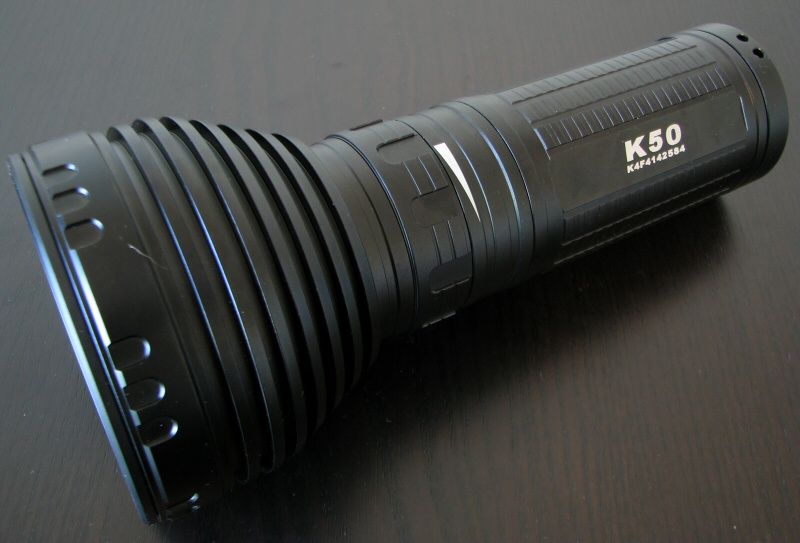
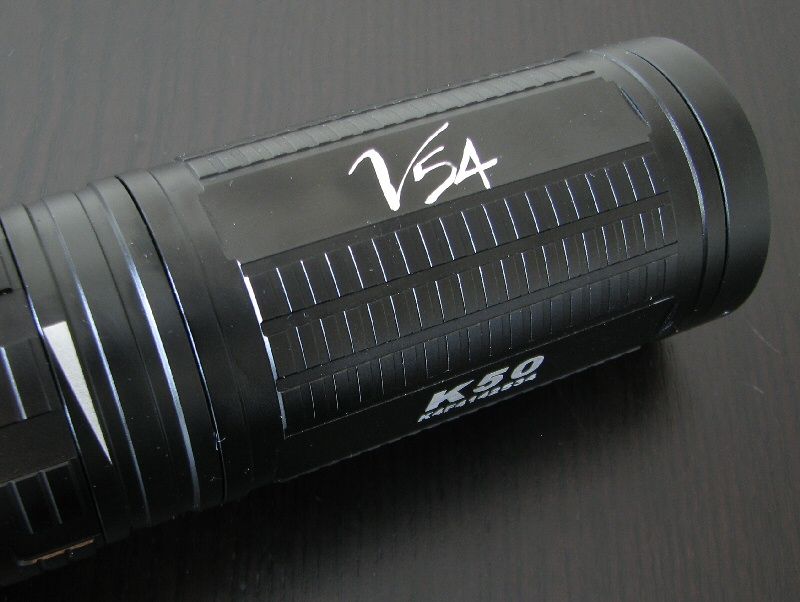
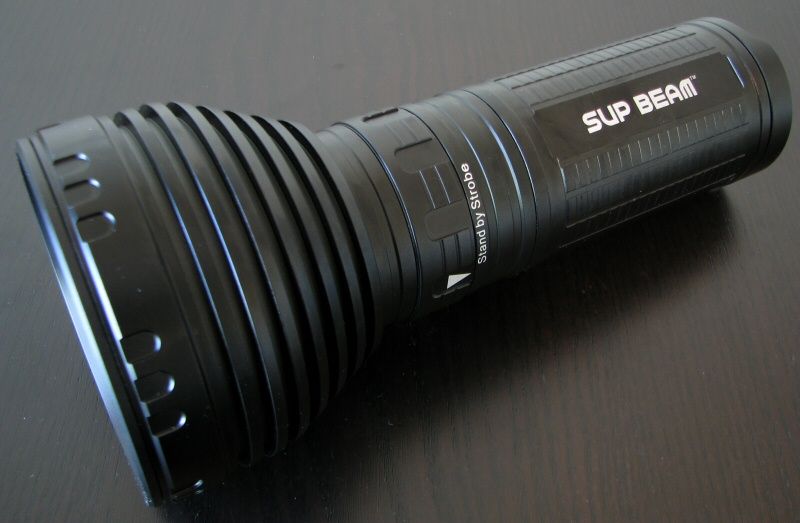
The K50 is a high-output "thrower" light from SupBeam, featuring many of the classic SupBeam features (e.g., in-light charging through a magnetic dock). In my previous review of the stock version of this light, I determined that it is an excellent all-around performer and an outstanding thrower.
As a result, I was curious as to how Vinh's souped-up version of this light compares. :devil:
For this review, I have Vinh's PDTc ("premium dedome tint – cool white") version of the K50vn. For more information about the K50vn, please see Vinh's K50vn discussion thread here on CPF. For more information on the PDT, please see this thread from Vinh.
Although this is specific review of the modified K50vn, I will be relying on a lot of the stock photos from my earlier K50 review (supplemented with the specifics of testing here, of course).
Let's see how the modified K50vn compares to the stock form, and to other high-output throwers in my collection. :wave:
Stock Supbeam K50 Reported Specifications:
Stock K50:
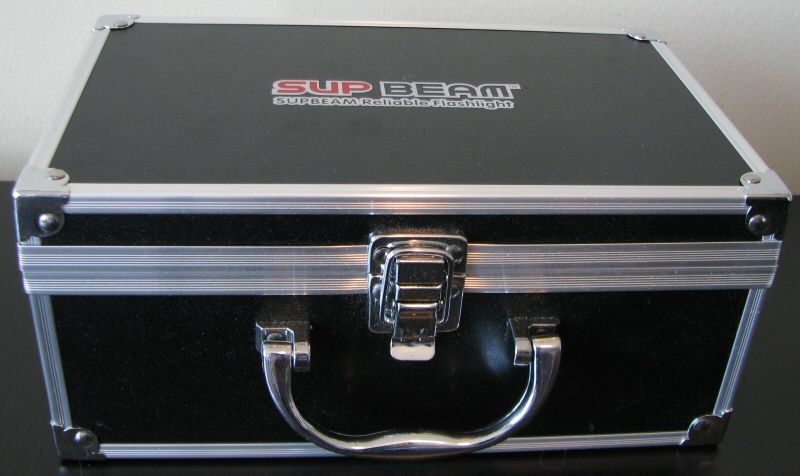
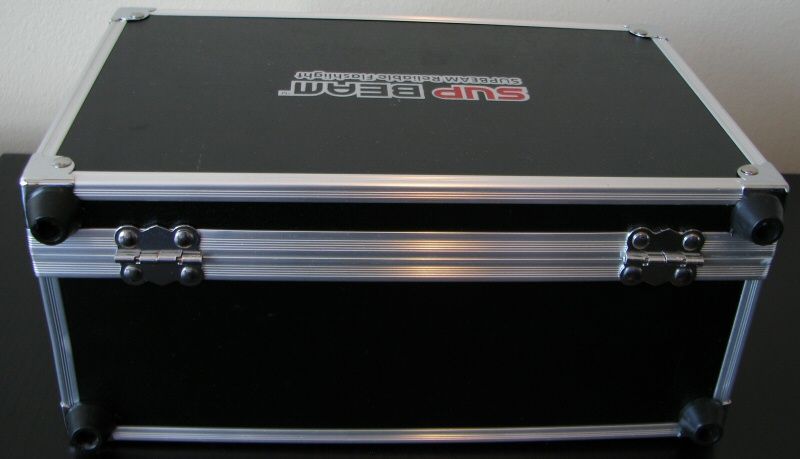
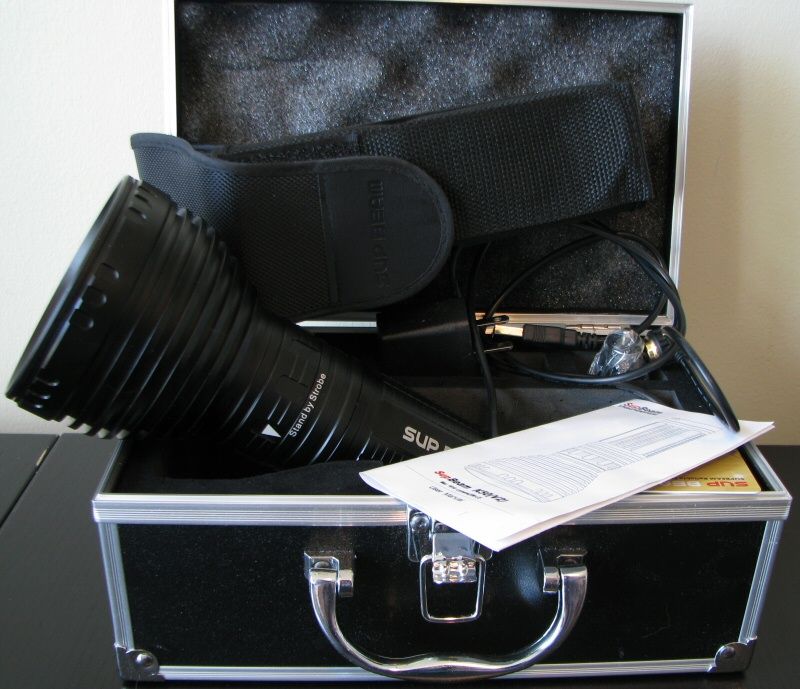
K50vn:
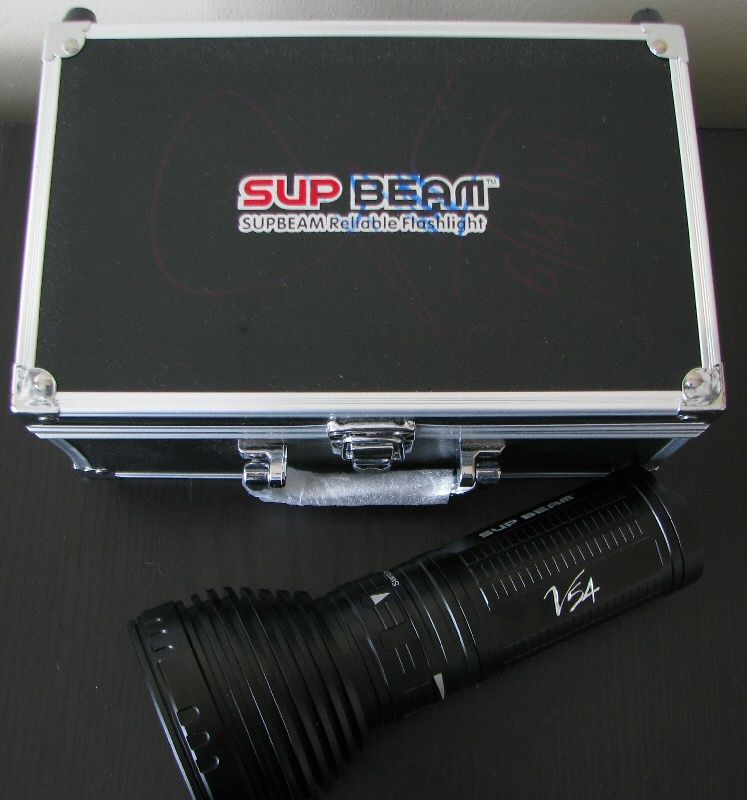
As per usual for a V54-modded light, packaging of the K50vn is the standard stock packaging of the K50 (signed and dated by Vinh). The K50 comes in a display-style presentation case with metal closing clasps and hinges. Along with the light is a holster, extra o-rings, spare boot switch cover, decent quality wrist strap, USB charging cable as AC adapter, 12V DC car adapter, warranty card, and manual.
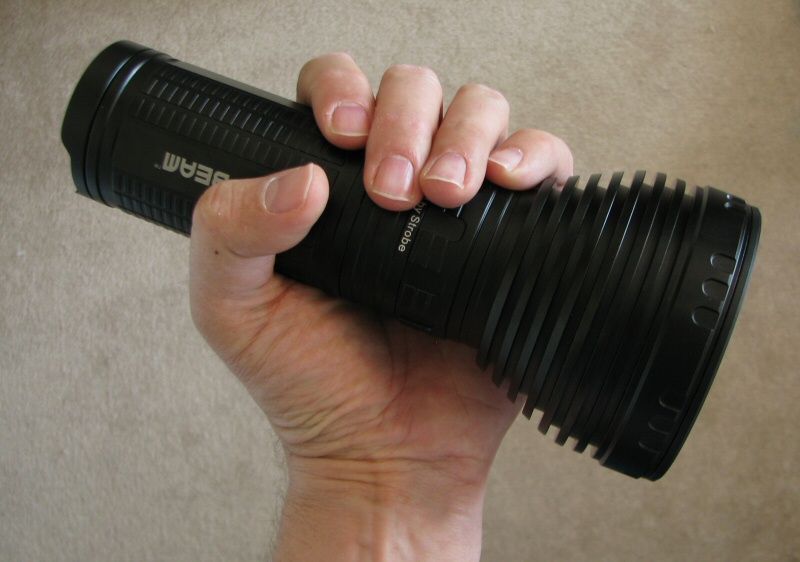
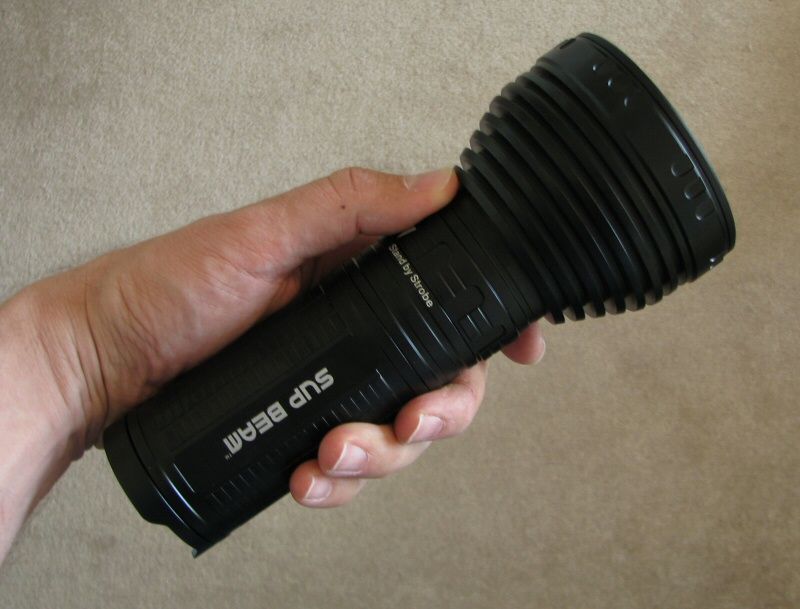
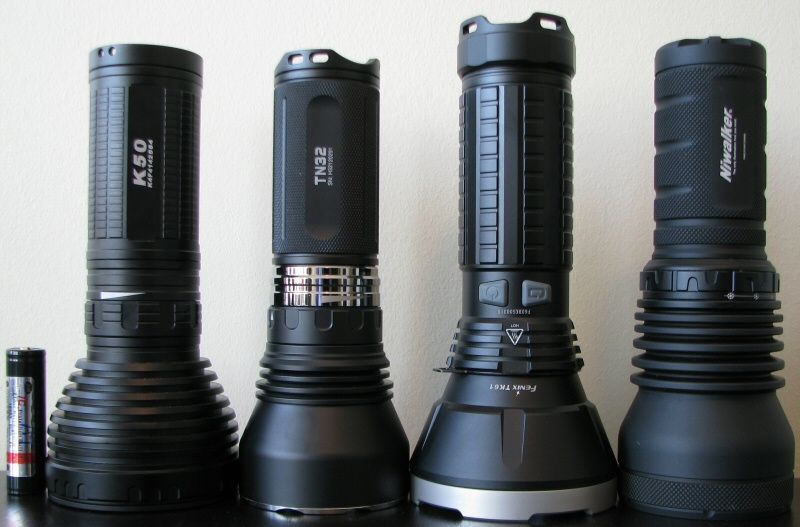
From left to right: AW protected 18650 2200mAh; SupBeam K50; Thrunite TN32; Fenix TK61; Niwalker BK-FA01.
All dimensions are directly measured, and given with no batteries installed:
SupBeam K50vn: Weight: 645.9g, Length: 230mm, Width (bezel): 90.1mm
SupBeam K50: Weight: 645.0g, Length: 230mm, Width (bezel): 90.1mm
ArmyTek Barracuda (XM-L2): Weight 400.8g, Length 264mm, Width (bezel): 64.0mm
Fenix TK61: Weight: 605.7g (790g with 4x18650), Length: 218mm, Width (bezel): 96.0mm
Fenix TK61vn: Weight: 608.0g (792g with 4x18650), Length: 218mm, Width (bezel): 96.0mm
Fenix TK75: Weight: 516.0g (700g with 4x18650), Length: 184mm, Width (bezel): 87.5mm
Niwalker BK-FA01 (XM-L2): Weight: 682.3g (864g with 4x18650), Length: 209mm, Width (bezel): 80.0mm, Width (tailcap): 50.3mm
Thrunite TN32 (XM-L2): Weight: 655.9g (808g with 3x18650), Length: 201mm, Width (bezel): 79.0mm
Skilhunt K30-GT (SBT-90): Weight: 635.9g (773g with 3x18650), Length: 199m, Width (bezel): 76.0mm
Stock K50:
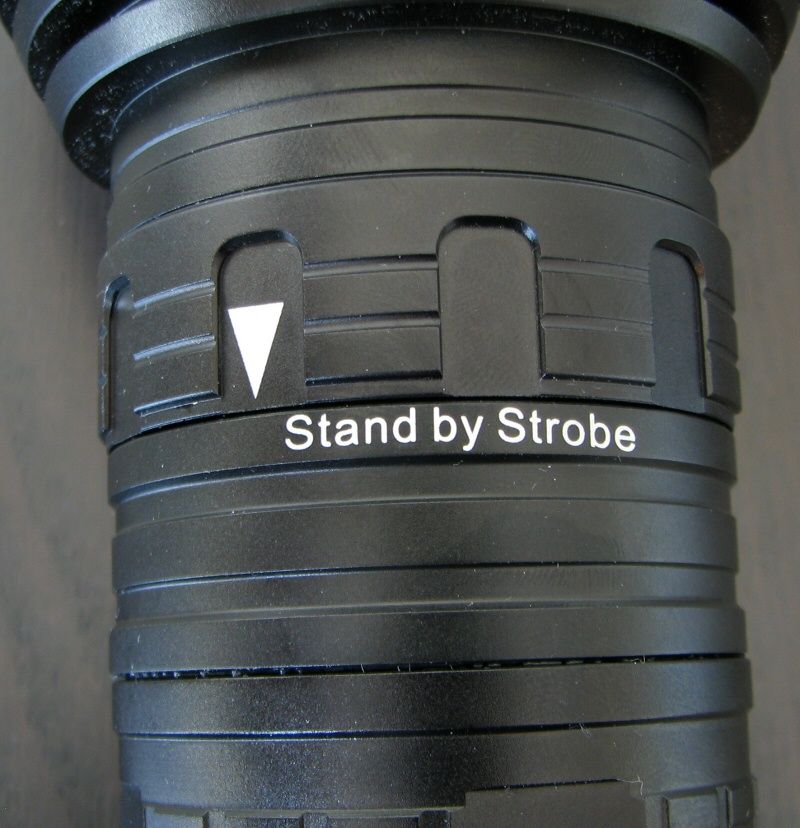
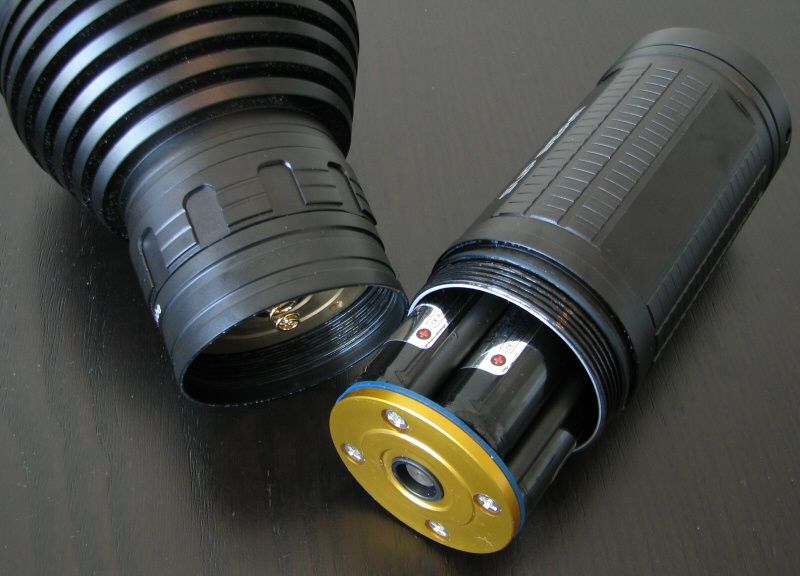
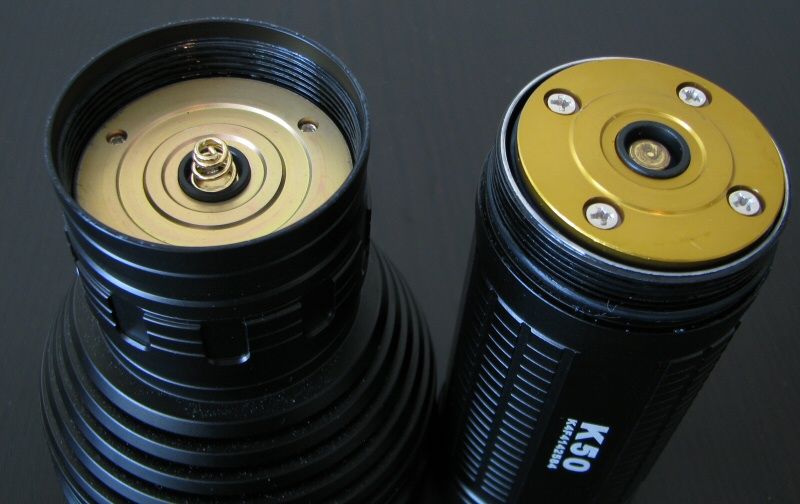
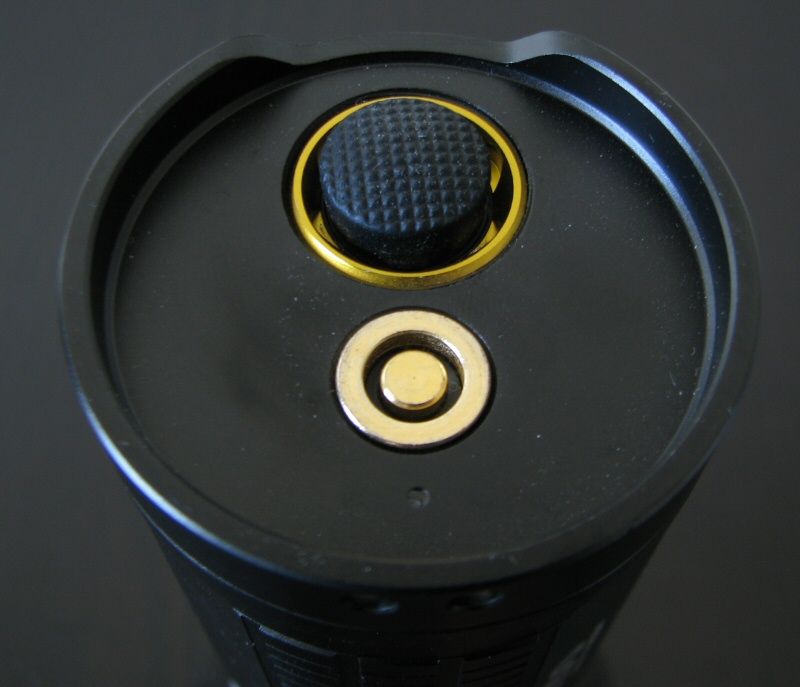
K50vn:

The only obvious difference to the external styling of the light is the custom "V54" engraving on the K50vn, should you request it. As such, my general build comments below refer to both the K50vn and stock K50.
As such, my general build comments below refer to both the K50vn and stock K50.
The K50 build is most reminiscent of the Thrunite TN3x-series lights – but with a tailcap and battery carrier similar to the SupBeam X40. Anodizing is a flat black, and seems to be in very good shape on my sample. Labels are sharp and clear, and include a serial number.
Rather than traditional knurling, the handle has a checkered pattern. Combined with the ridge detail on the control ring and head, overall grip is pretty good. The light can roll easily however.
The control ring feels and looks more like the Thrunite TN3x series than the typical X40/X60-series SupBeam lights. All black, there are slight indents (and raised checkered regions) on the control ring to help with feel. There is a label mark on the control ring that lines up with the labels on the head. The six constant output modes are not individually labeled, but there is a graded output bar pictogram over the first four levels (i.e., shows the direction to turn to raise or lower the output). There are firm detents at each level, with a slight click as you enter into each one.
Screw threads are traditional triangular cut, but seem of good quality. They are anodized, allowing you to lock out the light by a simple twist of the head.
The lights can tailstand. Tailcap looks the same as the X40, with cut-outs to facilitate access to the switch. Switch is a forward clicky switch (i.e., press for momentary, click for locked-on). Switch feel is identical to the X40, and has a slightly longer traverse than typical, but with a definite click. There is a charging dock in the tail that connects to the supplied USB/AC charging cable. See below for a discussion.
Internally, the modded K50vn lights received a number of upgrades – unfortunately, I can't show them to you, as they inside the head. In this case, Vinh has shored up the internal heatsinking by adding a copper heatsink, and upgraded various components (wires, solder joints, etc.).
In this case, Vinh has shored up the internal heatsinking by adding a copper heatsink, and upgraded various components (wires, solder joints, etc.). 
Let's take a closer look at the battery carrier:
Stock K50:
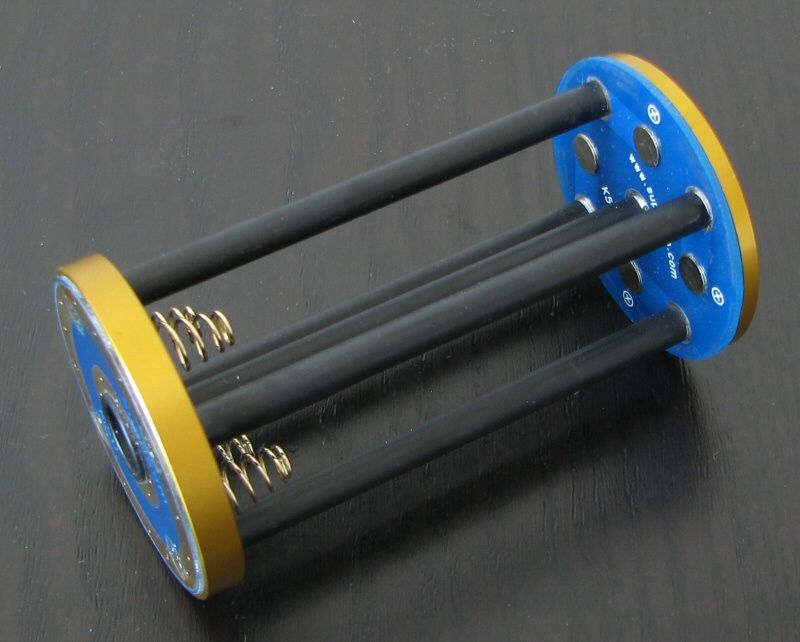
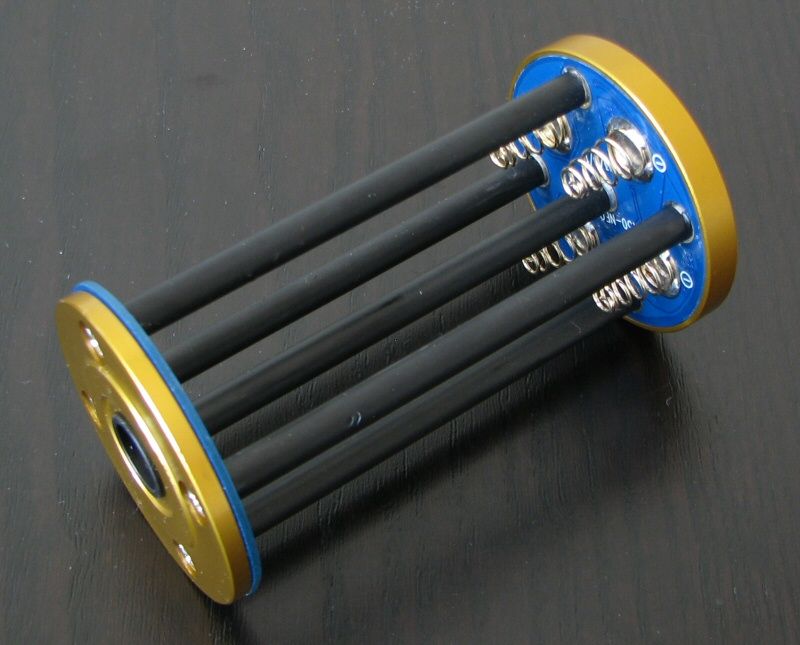
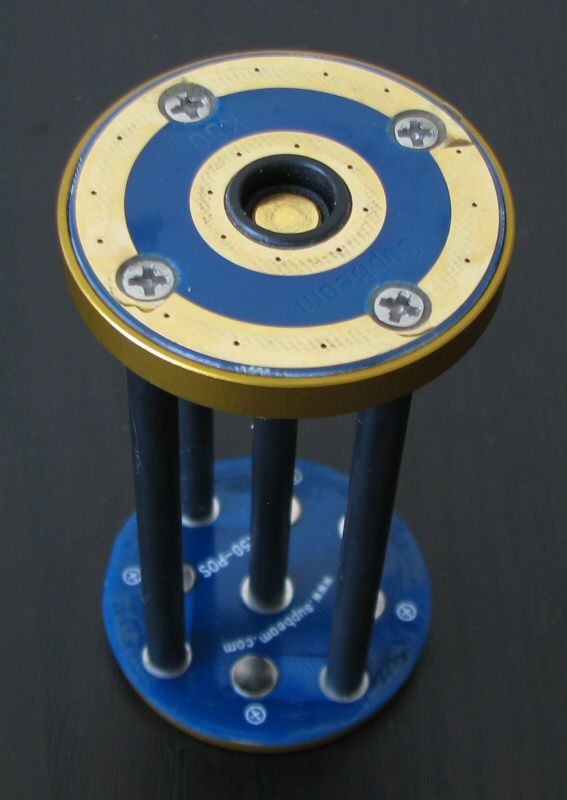
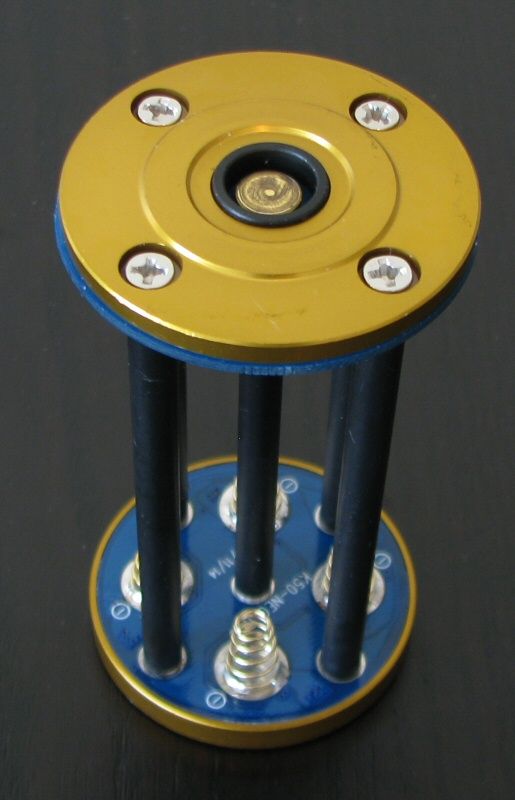
K50vn:
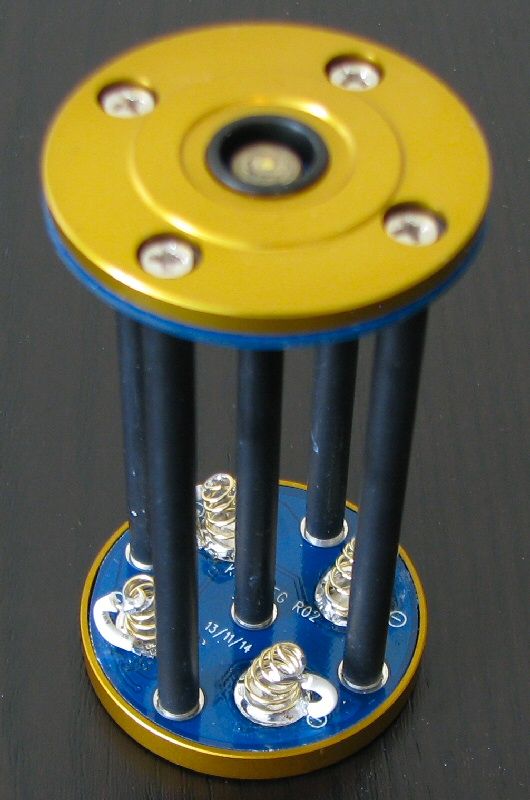
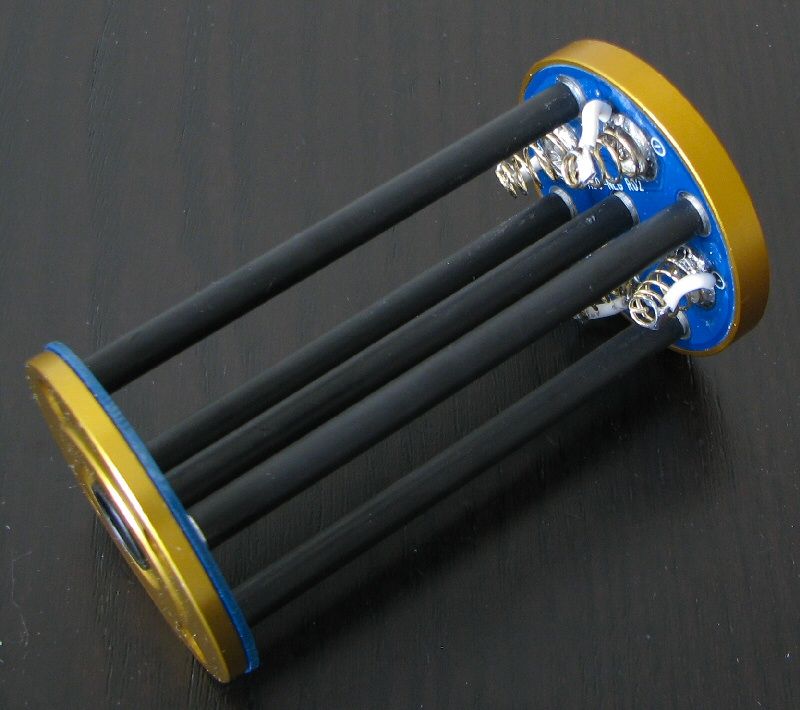
This is one of the few visible sources of Vinh's mod – you can see the additional wires soldered from the negative terminals to the springs in the carrier. This is likely to ensure good consistent current flow, through low-resistance wire.
The carrier is otherwise unchanged, and looks similar to the X40 (except holding 4x18650). The positive contact points inside the carrier are slightly raised, so all types of 18650 cells should work fine (i.e., true flat-tops, wide and small button-tops). There seems to be plenty of room in the carrier for length, so longer cells should fit fine. All the cells point the same way here (i.e., negative terminals at the base, positive terminals toward the head).
As with the other SupBeam lights, there is a unique dual-connection feature built-in to the charger. Despite how the carrier looks, the cells are actually arranged in a 4s1p arrangement when running the light (i.e., all cells in series, none parallel). The negative current path is carried by the body of the light, and the positive path connects through the spring in the head unit – when running the light. The situation is a lot more complex when charging, as I'll explain below.
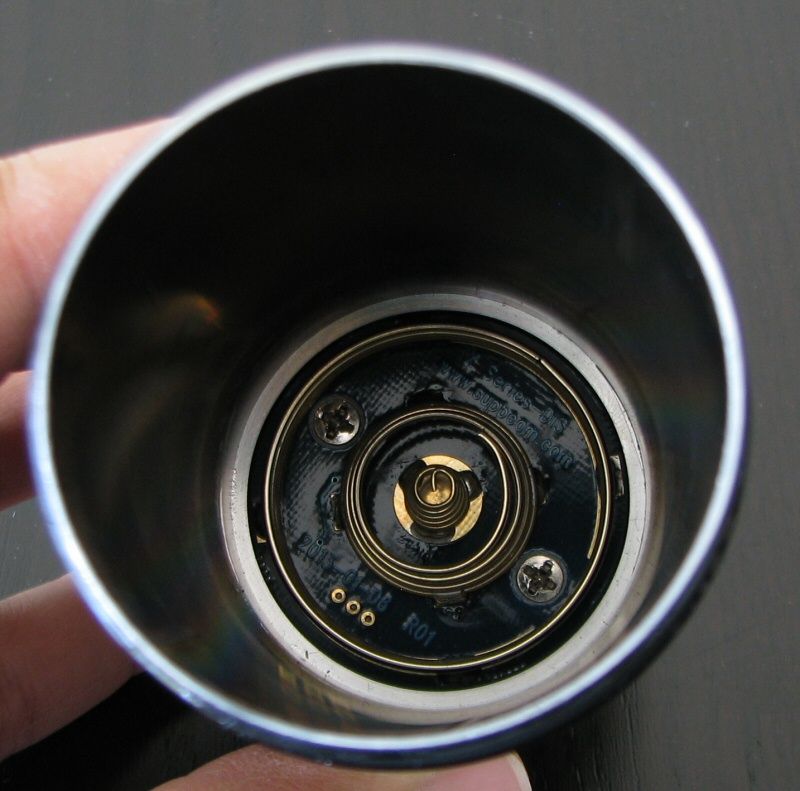
There is a triple set of springs in the base of the battery tube that make contact with the carrier. Normally, a single spring would be needed for simple operation, and two springs for in-series charging. The addition of a third spring (along with a more complex wiring design inside the carrier) allows the light to actually charge the cells in parallel, not series. This is a much safer way to charge cells, so kudos to SupBeam for developing this innovative dual-wiring design: :thumbsup:
The external charging dock is unchanged on the K50/K50vn from the X40. The charging dock is magnetic and there is no open voltage at the tail (i.e., no risk of shorting when cells are loaded). What you see at the exterior base are two metal circular contacts – these are connected to the terminals of the carrier through the springs. The charging cable directly attaches to the external contacts through a strong magnetic connection.
There is also a small LED indicator next to the charging dock. It is green when the light is on and the batteries are well charged (or, when charging, if the batteries are fully charged). It is orange when on and the batteries are partially discharged. It is red when on and the batteries are running low (or when batteries are being charged), and flashing red when the on and the batteries are <10% (or if there is a fault when charging and the charger has shut-off).
The light comes with a USB charging cable, but you have to plug the USB port into either included AC adapter or the 12VDC adapter to charge cells inside the light. Due to the parallel-charging design, the 500mA charging limit of USB 2.0 is just not going to cut it.
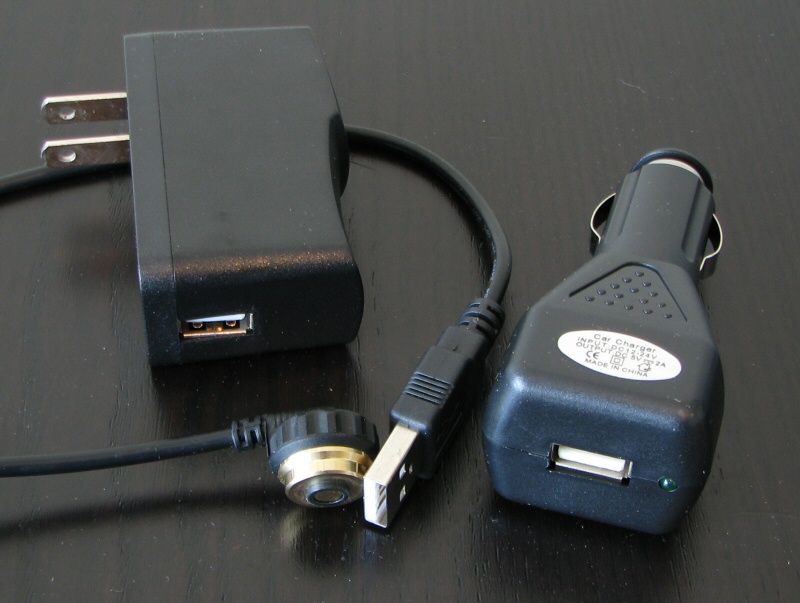
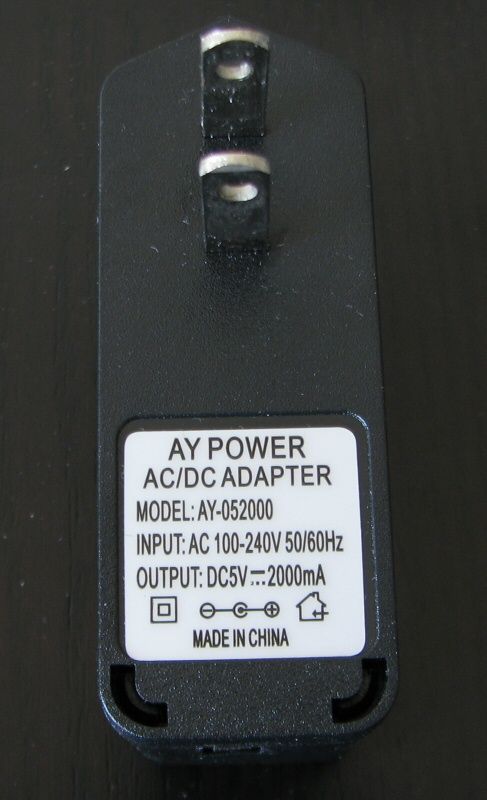
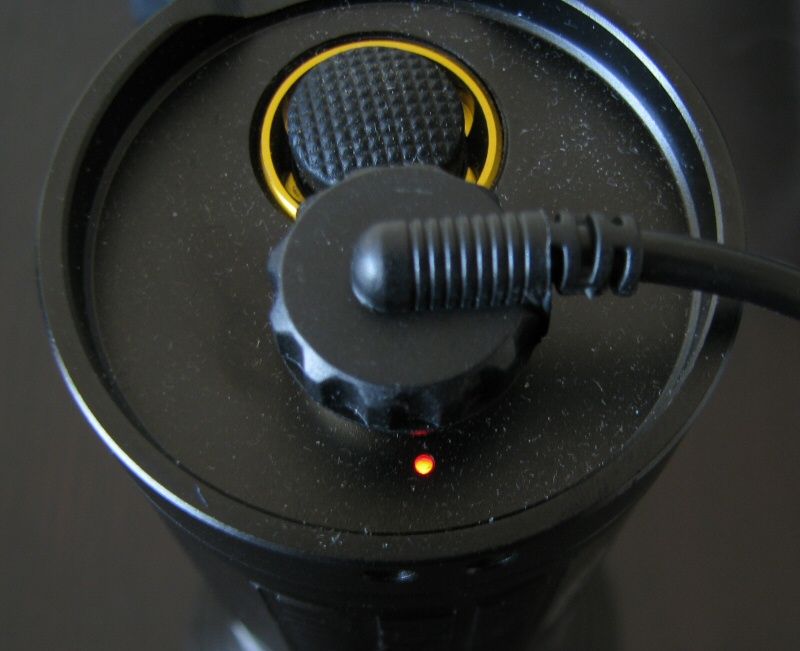
Please scroll down for some detailed charging current measures of the stock K50 later in this review. :wave:
Because of the strong magnetic pull of the charging cable head (i.e., it will attach itself to anything made of metal), I generally recommend you connect the head to the flashlight before you connect the AC/DC outlet. The risk of accidentally shorting the cable is quite low, as there is a raised plastic divider separating the inner and outer contacts on the head. But given that the magnet is fairly strong, I wouldn't want to trust that tiny bit of plastic to rule out the potential for even a momentary short.
The head of the light is another place where you can see the effect of the V54 mod.
Stock K50:
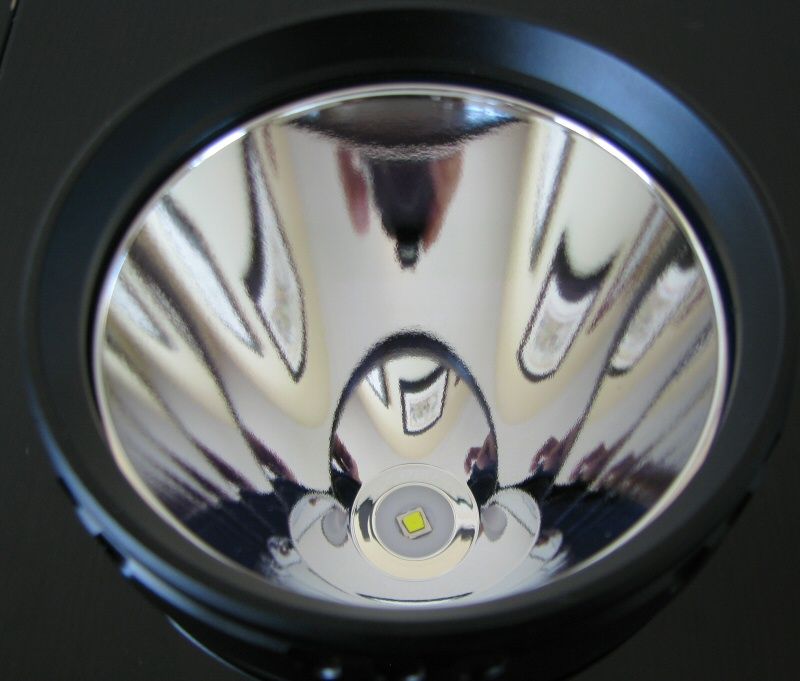
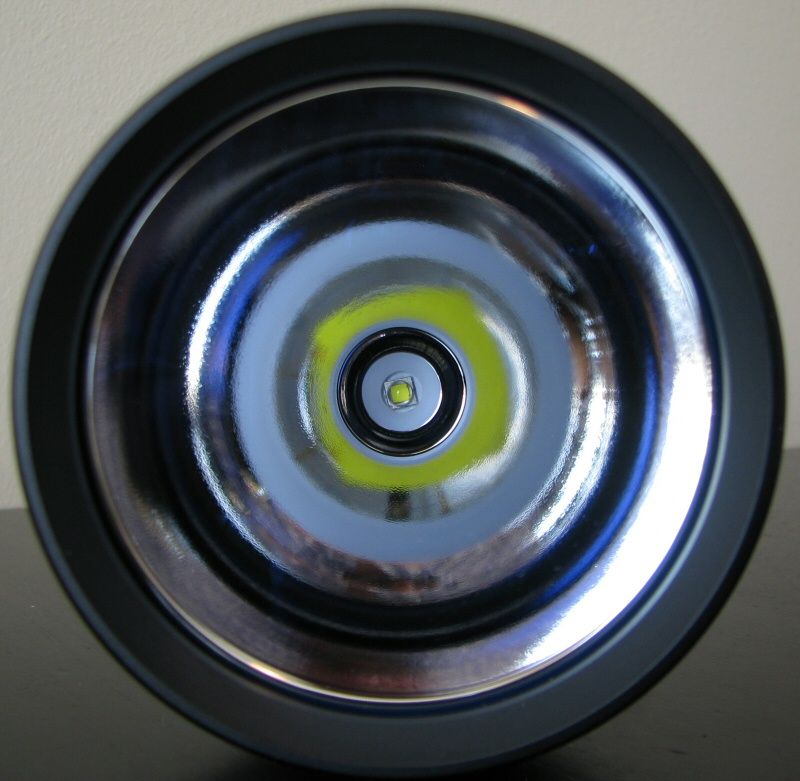
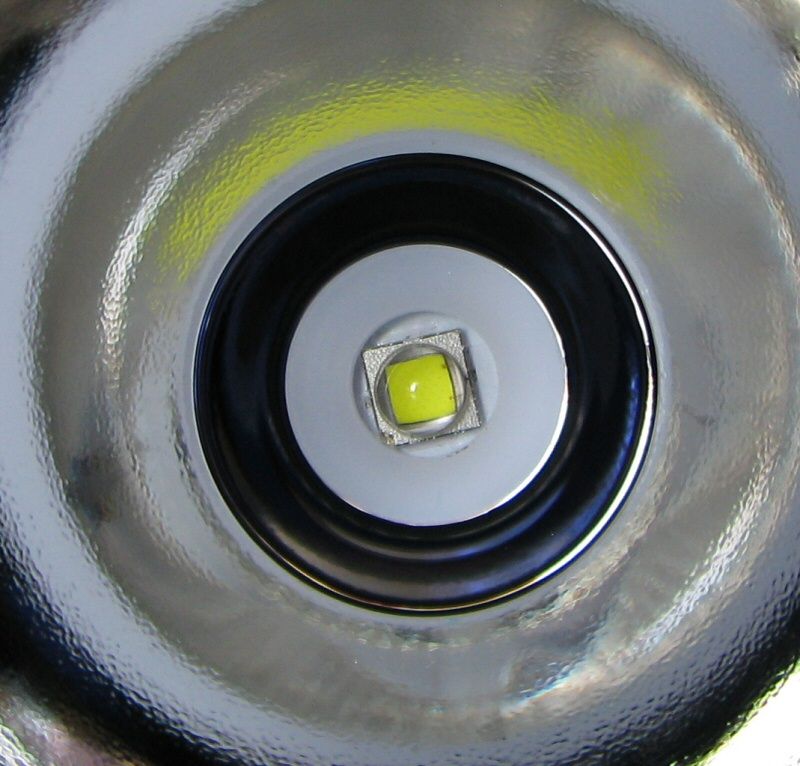
K50vn:
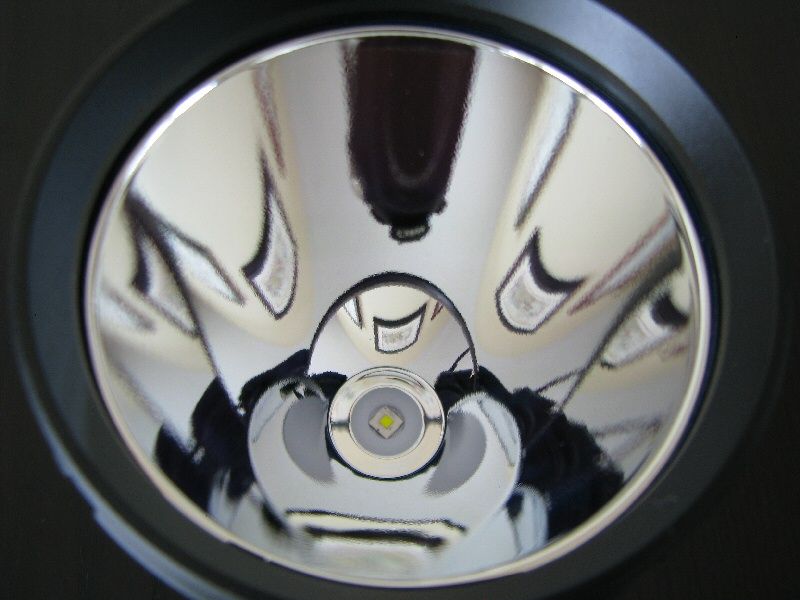
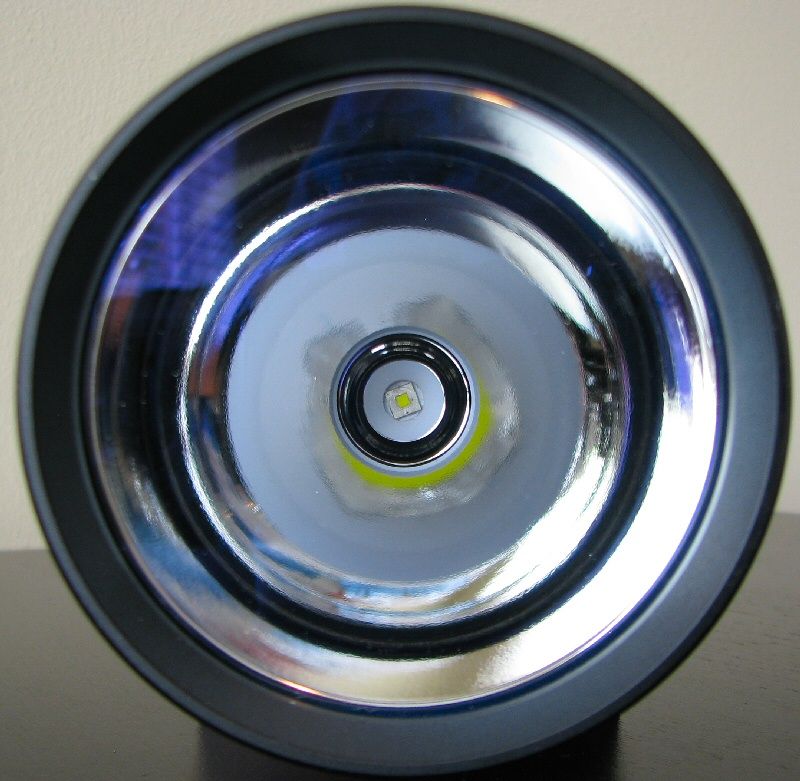
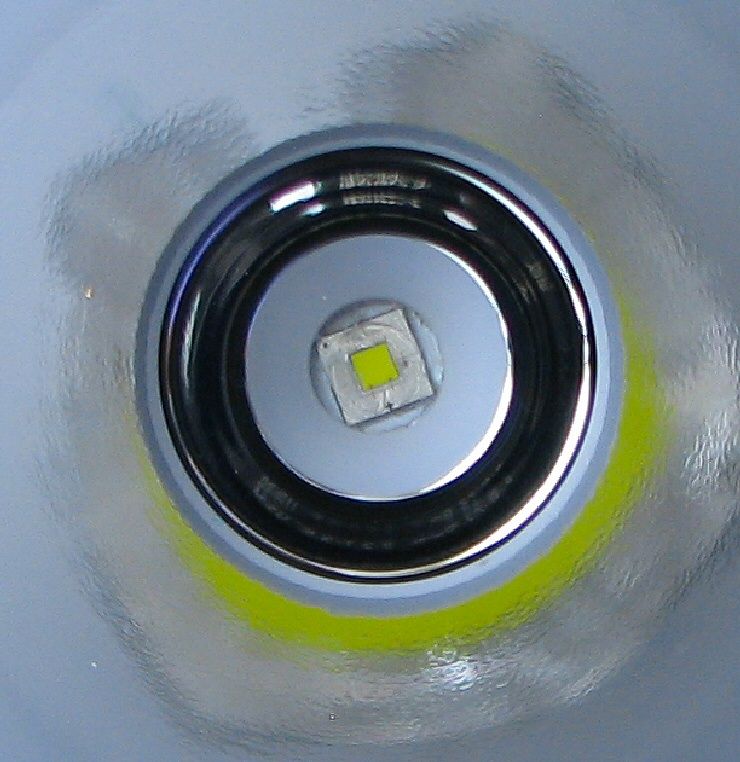
The stock K50 head is quite impressive – very large and deep, providing outstanding throw. This is one of the reasons I wanted to try the K50vn, to see how it compares. :devil: As before, the reflector has a fine texturing to it, but it is generally more similar to most smooth reflectors.
The dedome PDTc (premium dedome tint – cool white) on my sample came well centered (and well dedomed). The dedoming process greatly improves the focusing of the light. Scroll down for beamshots and direct intensity measures. :wave:
User Interface
The UI is unaffected by the mod. Turn the light off/on by the tailcap clicky – press for momentary, press and release (i.e., click) for constant on.
Change output modes by turning the control ring in the head. Arranged from left-to-right (looking down at the light, held in traditional flashlight carry), the modes are level 1 > level 2 > level 3 > level 4 > level 5 > level 6 (max) > standby > tactical strobe.
No light is produced on standby, but a miniscule current will be drawn to allow the circuit to respond to a ring turn (see below). As always, I recommend you store the light clicked-off at the tailcap, or locked-out by a head twist.
To charge the light, simply attached the magnetic charging dock to the port on the back of the light, and connect the other end of the cable to AC or DC power. Scroll down for an analysis of the charging current.
Video:
For more information on the modded K50vn, please see my brief overview here:
For more detailed information on the K50, including general build and user interface, please see my video overview:
As with all my videos, I recommend you have annotations turned on. I commonly update the commentary with additional information or clarifications before publicly releasing the video.
Strobe
There is no sign of PWM on any level – the light is current-controlled. :thumbsup:
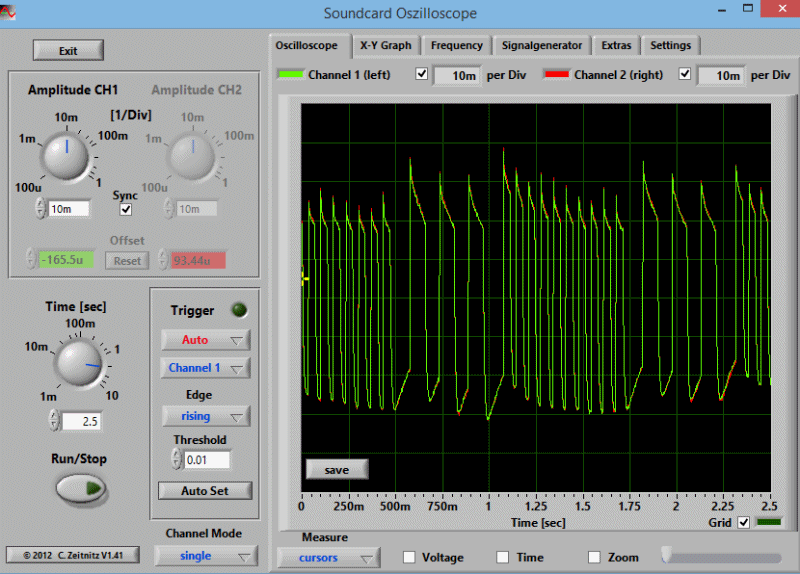
The K50 uses an oscillating strobe design, switching between two frequencies every ~0.55secs or so. Here is a blow up of the two frequencies:
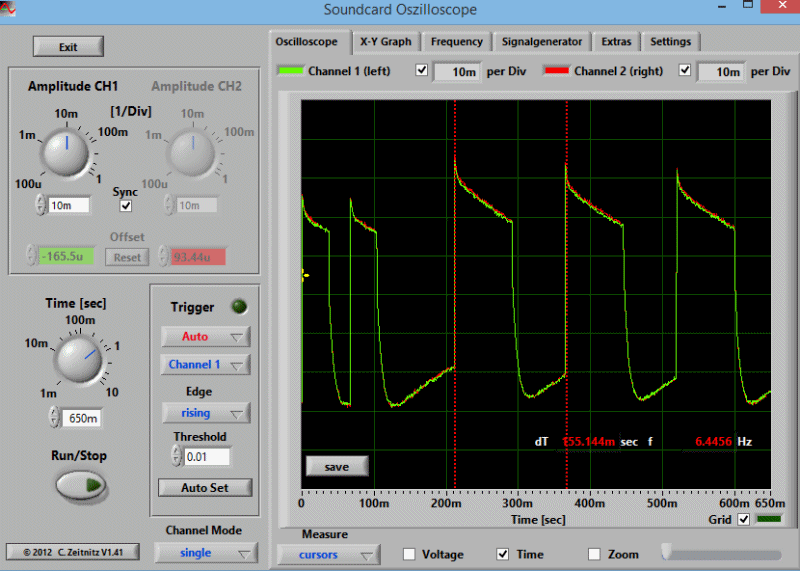
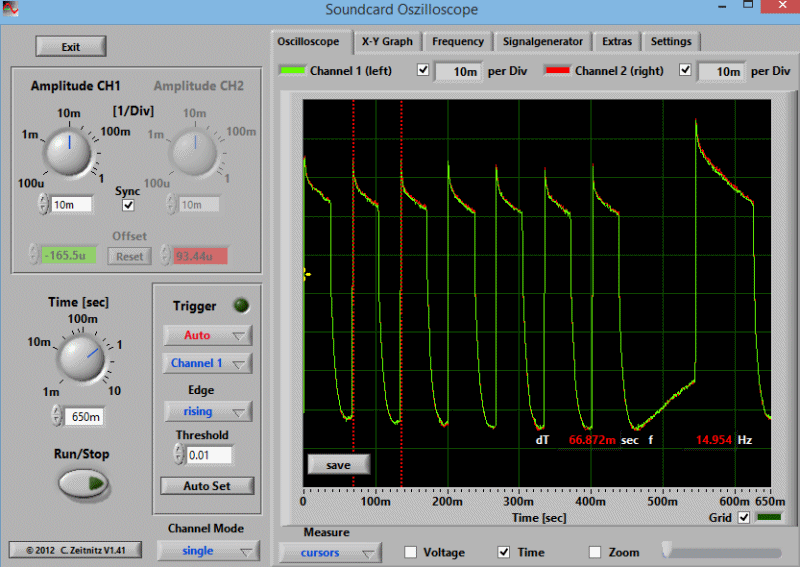
As you can see, it rapidly switches between 15.0Hz and 6.5Hz. I haven't bothered re-testing the K50vn, but it looks to be unaltered
Charging Current
Because the AC charger uses a USB connector to the charging cable, I was able to take direct measures of the charging parameters on the stock K50 (these should be the same for the K50vn). For these measures, I am using the new Xtar VI01 "USB Detector" (basically a specialized USB current/voltage meter). This model has recently been favorably reviewed by HKJ here.
For charging tests, I started with discharged AW protected 18650 cells, measuring ~3.0-3.4V at rest. For all these tests, I removed the USB detector after each reading was taken. Note that the voltage reading on this device refers to the input voltage (i.e., from the charging brick).
Initial charging current and input voltage:
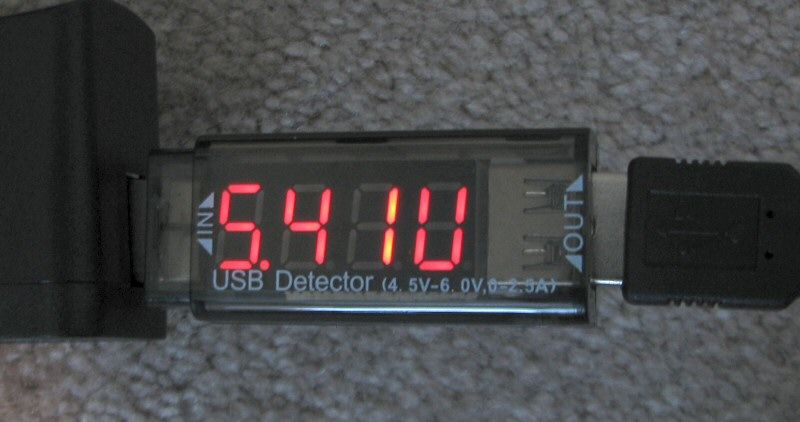
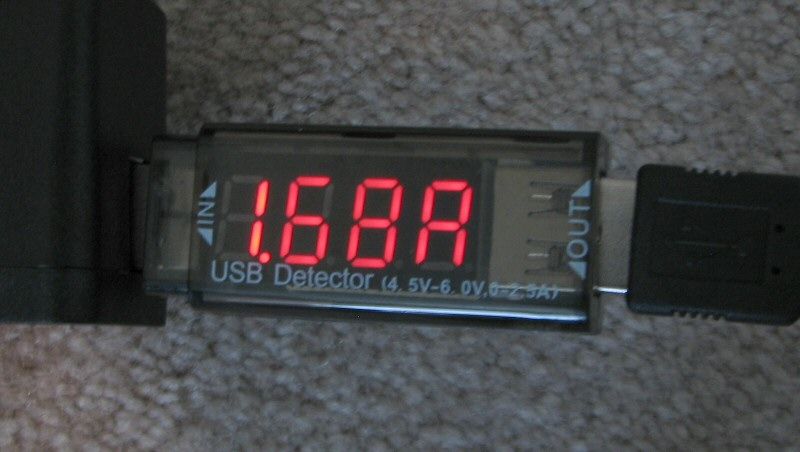
As you can see, charging started at 1.68A with a typical USB 5.41V input voltage ("U" is meant to represent Volts on the top display above). This is reasonable given all the cells were not fully discharged. Recall that the AC adapter has a max charging rate of 2A.
After 4 hours of charging, I re-measured charging current and input voltage:
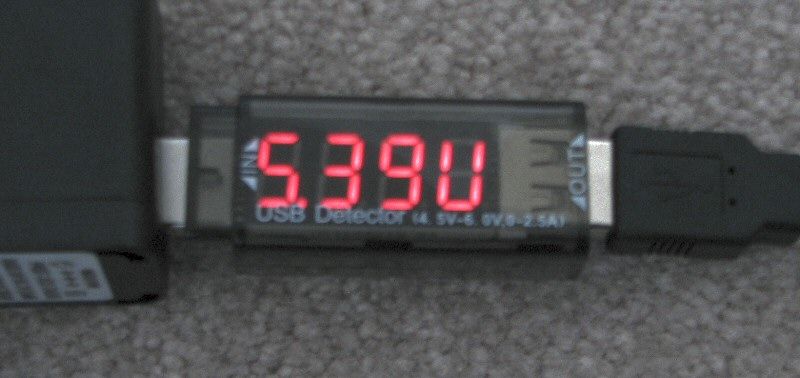
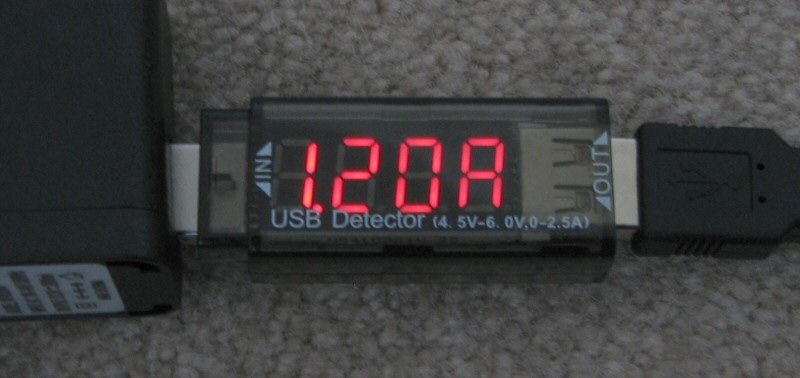
As you can see, the charging current has dropped down to 1.20A at this point, with a consistent input voltage, as expected.
After 5 hours and 20 mins of charging:
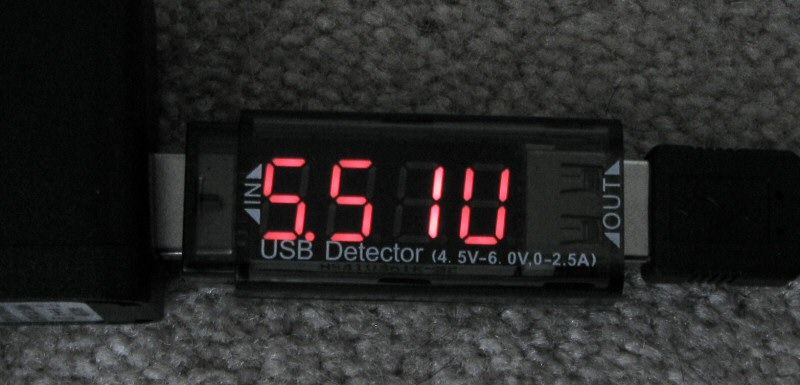
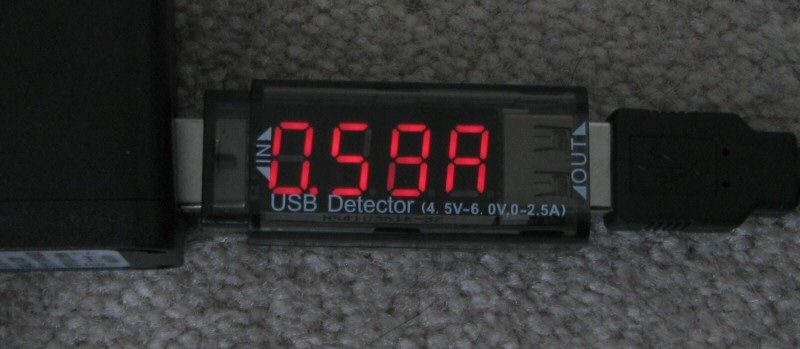
Charging current has now dropped to 0.59A, still with a fairly consistent input voltage. As you might expect, it won't be long until charging terminates.
In my testing, the charging indicator went green ~10 mins later, for a total charging time of 5hr 30mins. Resting voltage of the AW 2200mAh batteries was ~4.16-4.22V.
This is very reasonable charging time and acceptable resting voltage at termination.
Standby Drain
I don't see any evidence of a current drain between the head and carrier when the clicky switch is off. However, on other lights that use a similar design (e.g., Thrunite TN3x series), I know there is an additional circuit to assist the switch when high current draw is required. This necessitates a secondary circuit in the tailcap that has its own standby drain when connected to the carrier. Typically, these are in the uA range and not a concern in practice (although it would be additive to the carrier drain below when fully connected). Note that to break this current, you would need to actually remove the carrier from the handle.
Due to the rather complex dual serial and parallel arrangement inside the carrier (controlled by an internal circuit), there is also a small standby drain internal to the carrier. I measured this current as a tiny 7.5uA on the K50. I am not sure if that measurement refers to an in-series or in-parallel current, but either way it would be pretty negligible. Note that this tiny current is present whenever batteries are installed in the carrier (whether it is inside the light or not).
The above currents are pretty minimal and not a concern in practice. And the K50vn should be no different in any regard.
Finally, there must be a standby drain when the clicky switch is turned on and the light is in standby position of the control ring. I measured this traditional standby current as 67uA on four cells (on my stock K50). This is similar to my Thrunite TN32, and not a major concern. Assuming that the standby drain is for the cells in series (given that the light runs with cells series), that would take almost 5.3 years to fully drain 3100mAh cells (although you would need to factor in the above two minor contributions as well, to get a more reliable estimate).
Beamshots:
And now, what you have all been waiting for. All lights are on their respective 18650 battery sources, about ~0.75 meter from a white wall (with the camera ~1.25 meters back from the wall). Automatic white balance used on the stock lights (to minimize tint differences), and Daylight white balance used on the V54 modded lights.
All lights are on their respective 18650 battery sources, about ~0.75 meter from a white wall (with the camera ~1.25 meters back from the wall). Automatic white balance used on the stock lights (to minimize tint differences), and Daylight white balance used on the V54 modded lights.
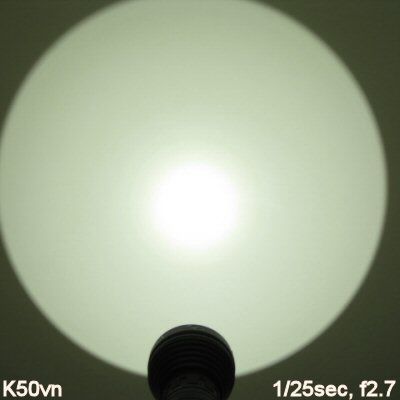
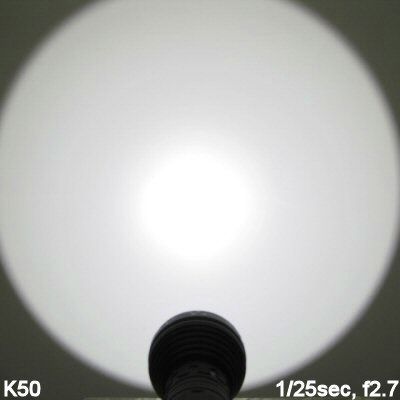
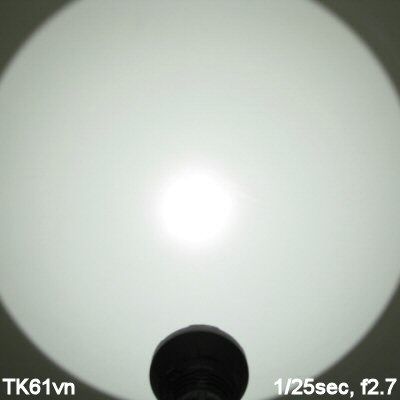
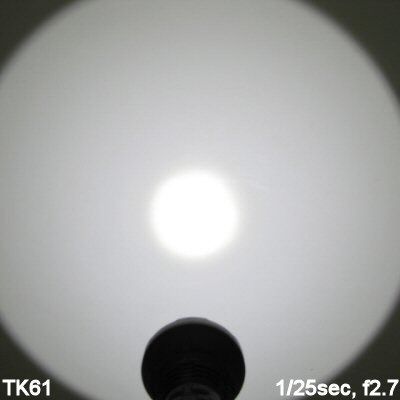
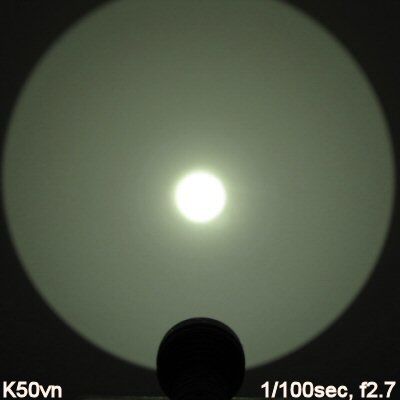
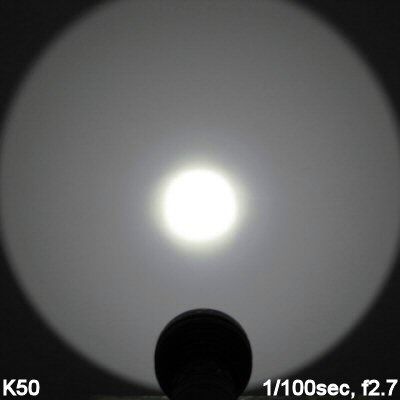
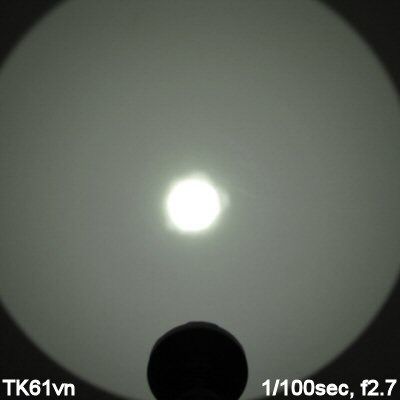
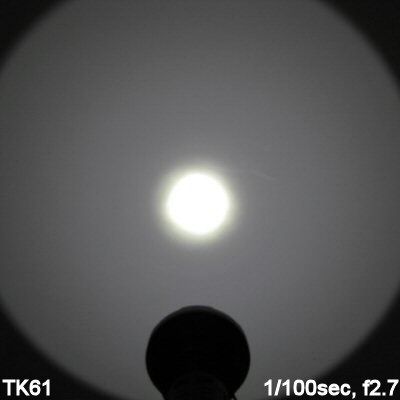
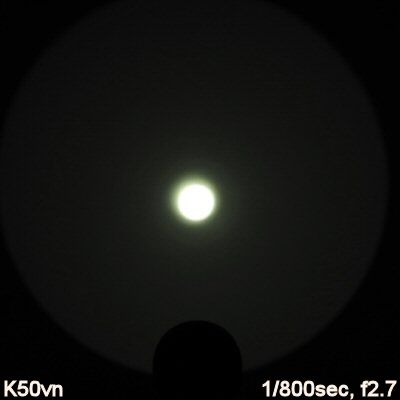
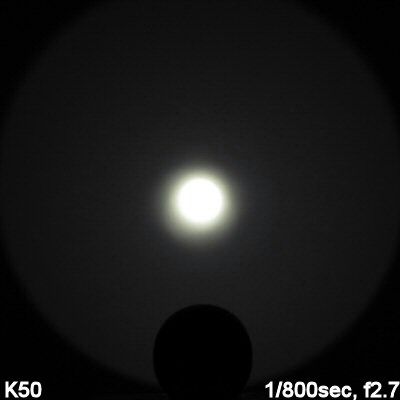
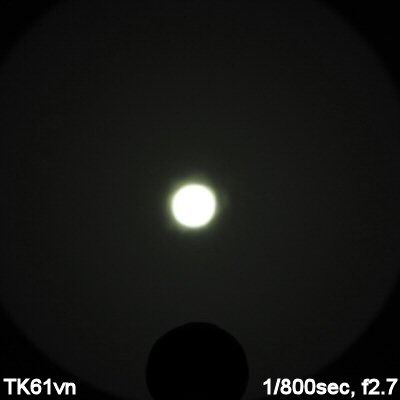
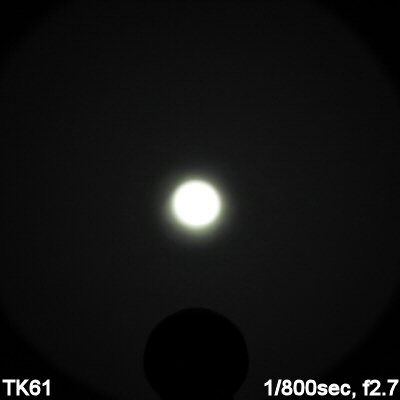
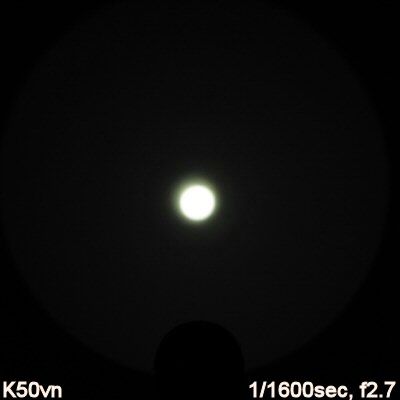
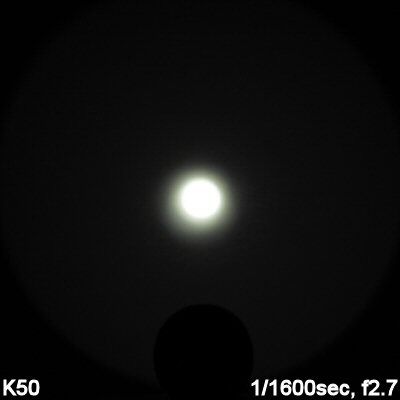
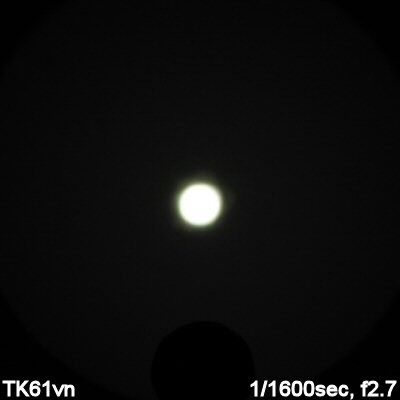
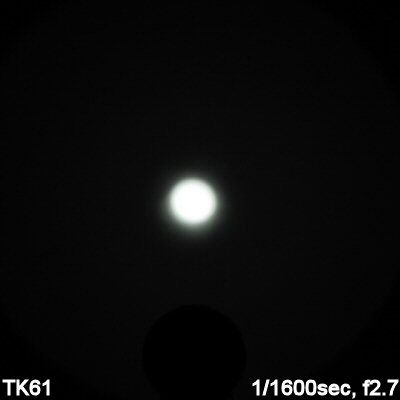
As always, it's hard to tell much about peak intensity throw at such ridiculously close distances. The most obvious observation is that the PDTc-equipped K50vn has a more focused beam for greater throw, compared to the stock K50. The PDTc is also slightly greener in tint compared to the earlier PDT on the TK61vn (which I believe Vinh now refers to as PDTn).
The most obvious observation is that the PDTc-equipped K50vn has a more focused beam for greater throw, compared to the stock K50. The PDTc is also slightly greener in tint compared to the earlier PDT on the TK61vn (which I believe Vinh now refers to as PDTn).
The comparison to the TK61/TK61vn is interesting – in that case, you might able to see that overall output was significantly increased as part of the mod from stock (although tint changes may obscure this somewhat). I don't see much of an obvious overall output increase on the K50vn relative to the stock K50, but I will discuss this further below with the more detailed testing below.
Here are some indoor shots in my basement. For your reference, the back of the couch is about 7 feet away (~2.3m) from the opening of the light, and the far wall is about 18 feet away (~5.9m). Below I am showing a couple of exposures, to allow you to better compare hotspot and spill.
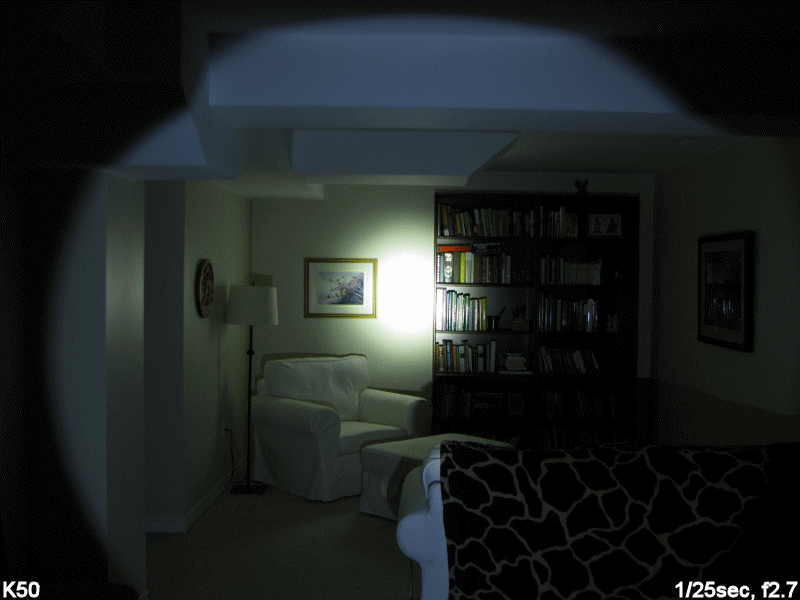
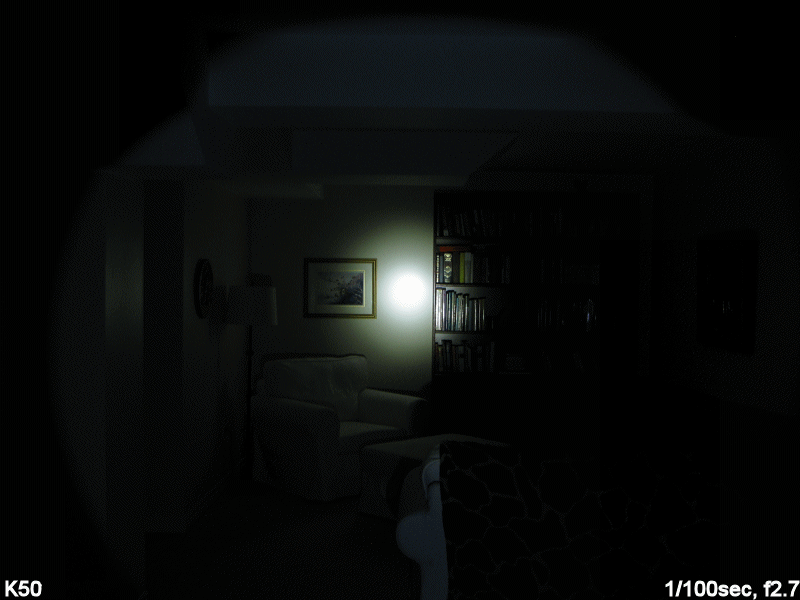
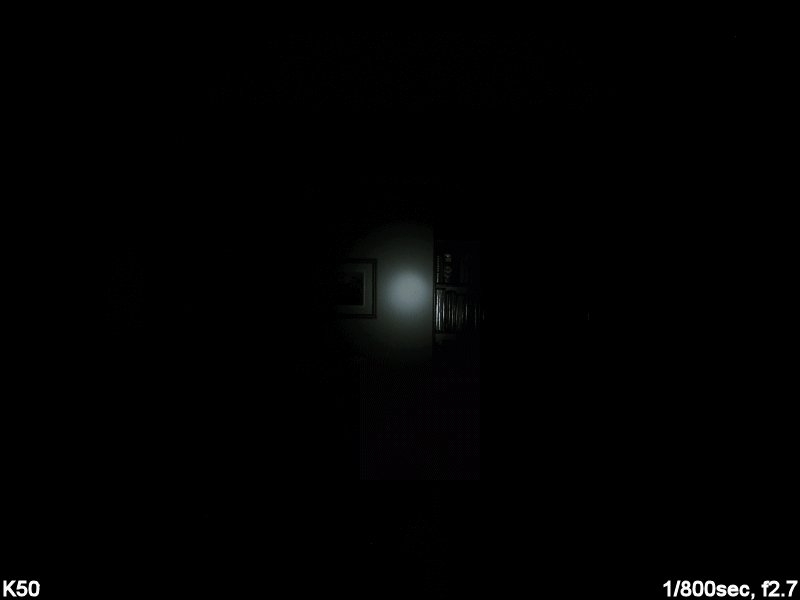
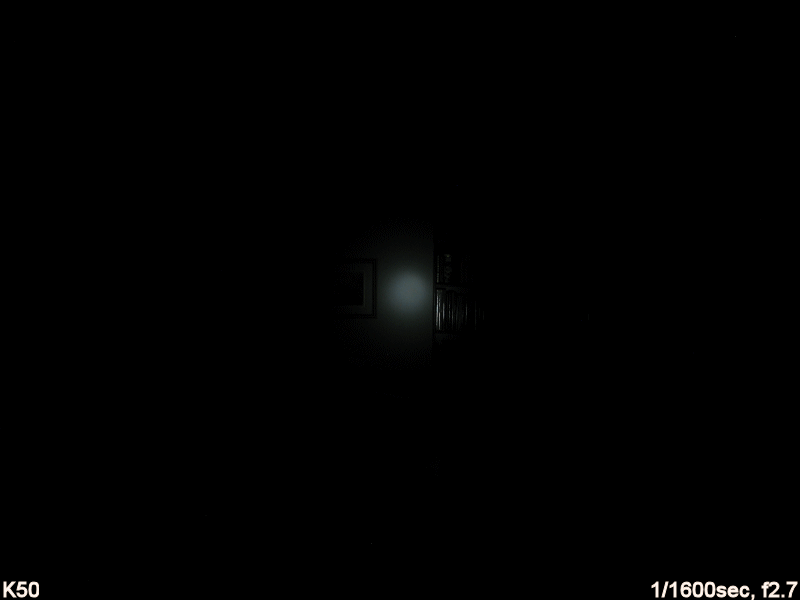
Although the TK61vn has a bigger central hotspot than the K50vn, it is also brighter (and therefore, will throw further). The design of the K50 reflector seems to result in a brighter (and wider) corona around the hotspot- thus effectively diminishing some of the light that would make its way into the center of the spot.
To say more, we will need to move to further distances. For outdoor shots, these are done in the style of my earlier 100-yard round-up review. Please see that thread for a discussion of the topography (i.e. the road dips in the distance, to better show you the corona in the mid-ground). Camera locked to Sunlight white balance, to show tint in a consistent way.
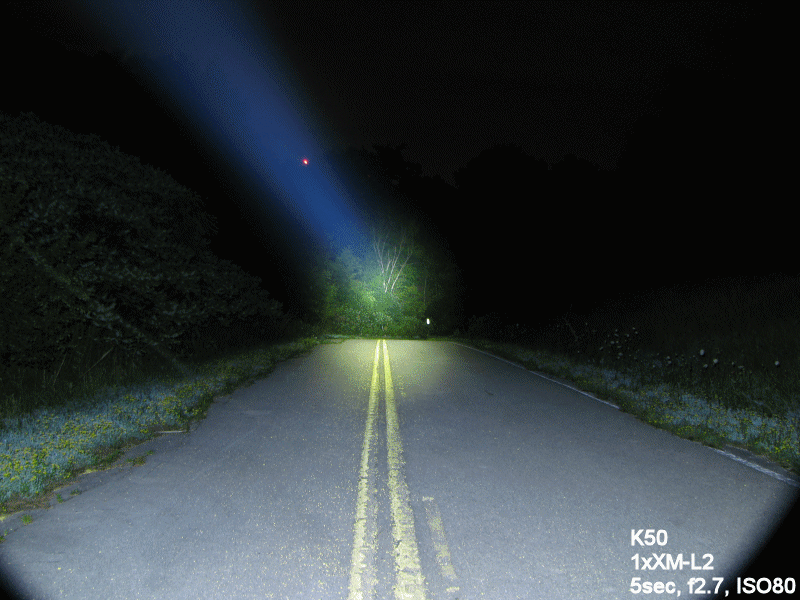

I think this really shows it well – the K50vn has a tighter central hotspot than the TK61vn, but a wider corona. What this means is that the K50vn lights up a wider area at 100 yards (i.e., look at the zoomed in shots above). However, at further distances (like say 500+ yards, not shown), you would expect the TK61vn to put more light on target, with a larger area illuminated.
These are two lights where further distance beamshots would be helpful. I'll let you know if I figure something out.
I'll let you know if I figure something out.
Scroll down for direct beam measurements.
Testing Method:
All my output numbers are relative for my home-made light box setup, as described on my flashlightreviews.ca website. You can directly compare all my relative output values from different reviews - i.e. an output value of "10" in one graph is the same as "10" in another. All runtimes are done under a cooling fan, except for any extended run Lo/Min modes (i.e. >12 hours) which are done without cooling.
I have devised a method for converting my lightbox relative output values (ROV) to estimated Lumens. See my How to convert Selfbuilt's Lightbox values to Lumens thread for more info.
Throw/Output Summary Chart:
My summary tables are reported in a manner consistent with the ANSI FL-1 standard for flashlight testing. Please see http://www.flashlightreviews.ca/FL1.htm for a discussion, and a description of all the terms used in these tables. Effective July 2012, I have updated all my Peak Intensity/Beam Distance measures with a NIST-certified Extech EA31 lightmeter (orange highlights).
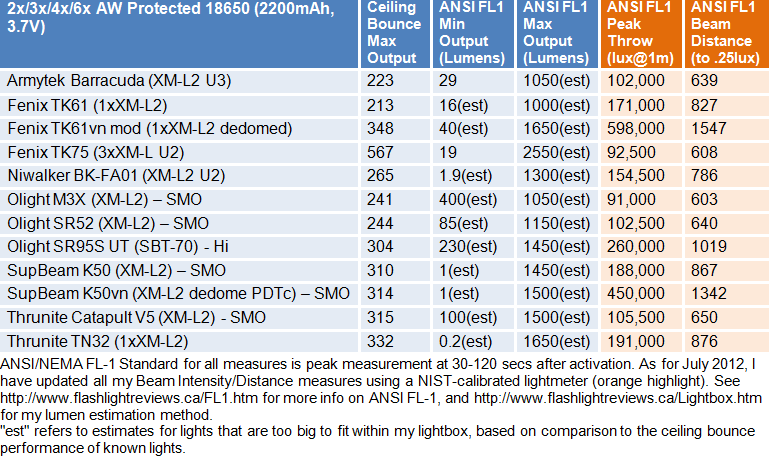
As previously mentioned, the mod of the TK61vn produced a significant increase in both peak intensity throw and overall output, compared to its stock form. In contrast, I find the increase in overall output on the K50vn mod to be modest. Peak intensity has certainly increased greatly though (thanks to the dedoming), resulting in my second-best thrower (after the TK61vn). :thumbsup:
To better compare output changes after the K50vn, here is a comparison table at all levels.
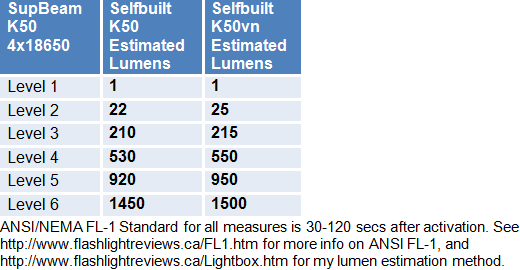
The difference in output after the mod is not great, although it was consistent – there was a ~3.5% increase across all levels on my K50vn mod. Normally, I would consider this to be within the range of expected variation across samples of a given light. Let's see how runtimes were affected …
Output/Runtime Comparison:
As always, please recall that I use 2200mAh AW Protected 18650 cells in all my standard runtimes.
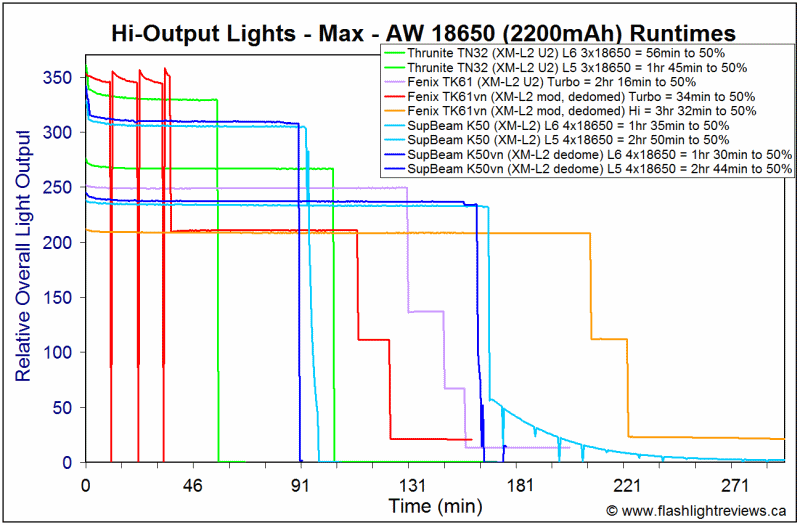
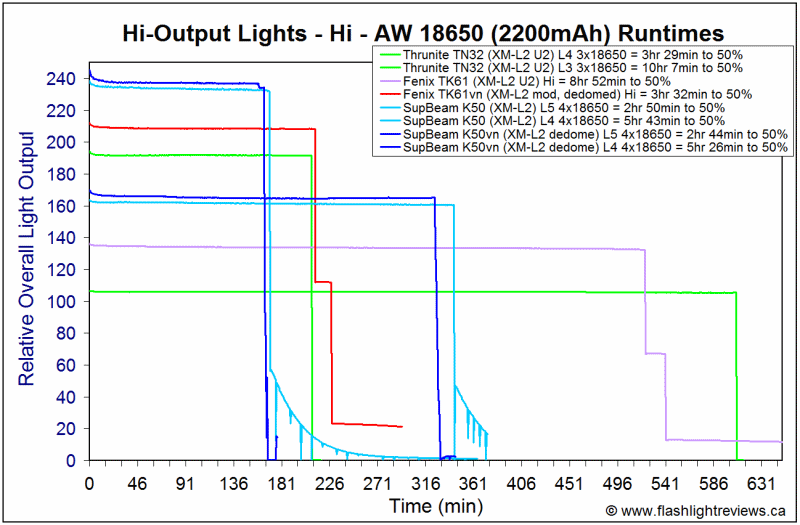
As you can see, there was a consistent slight increase in output on my K50vn (relative to the stock K50) – with a consistent slight decrease in regulated runtimes, as expected.
One other difference is that my K50vn dropped more rapidly to an ultra-low level once the cells fell out of regulation (compared to the my stock K50).
As before, my general conclusion is that the K50/K50vn is a well-regulated performer for this class, with good overall output/runtime efficiency.
In case you are wondering, here is how protected Panasonic NCR18650A 3100mAh cells perform in the lights, on max:
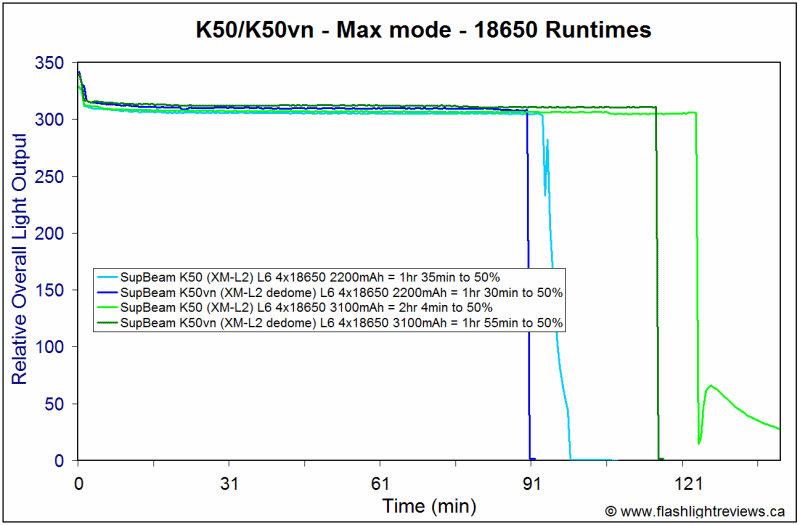
As expected, the 3100mAh cells show extended runtime compared to my standard 2200mAh cells, but regulation patterns are comparable.
Potential Issues
Stock K50
The light has a stand-by current when in the "Stand By" mode of the control ring. But this current is very low (67uA), and will not be problem for regular use. And you can easily break this current by clicking the tailswitch off, or loosening the head a quarter turn.
There is a standby current internal to the carrier, due to the unusual dual series and parallel connections. This current drain is negligible at 7.5uA in my testing however. Finally, there is likely a tertiary current for circuit assist to the physical switch. I have not disassembled to confirm, but these are typically in low uA range (and so again not a concern).
The magnetic charging cable worked well in my testing, with no open voltage reading at the tailcap (and so no risk of shorting your battery inside the light). Like other recent SupBeam lights, the K50 also uses an innovative carrier that supports in-series running of the light, but in-parallel charging. This is good news for in-light charging, as in-series is not recommended for multiple cells.
Only 18650 Li-ion cells may be used in the light (i.e., doesn't support multiple CR123A primary cells).
K50vn
The standard potential issues of the stock K50 apply to the K50vn.
Dedoming of the emitter (to increase throw) also tends to produce a warmer overall beam tint. As expected the "premium dedome tint – cool white (PDTc)" gave a slightly green-yellow tint (even moreso than the earlier PDT on my TK61vn). Long-term reliability of dedomed emitters is unknown.
One advantage to the K50vn is the updated heatsinking and circuit/carrier tweaks (i.e., improved soldering, thicker gauge wires, etc.) that Vinh performs. Since the overall output is not driven appreciably higher on my K50vn (i.e., only ~3.5% higher compared to stock in my testing), I would expect improved longevity thanks to Vinh's mods. Of course, modding voids all manufacturer warranties, but I know that Vinh stands behind his products.
Preliminary Observations
In my testing of the stock K50, I felt that this was a well-designed example of a "thrower" light. It has a sturdy build, excellent user interface, and innovative features (like the in-parallel magnetic charging solution). As such, I was curious to how this light would perform under Vinh Nguyen's expert ministrations.
Given my favorable impression of this light, I offered to buy a K50vn outright from Vinh. But he insisted on providing one for review instead (although I did convince him to at least let me make a donation for his efforts).
I am happy to report that the dedome K50vn is an outstanding thrower – second only to the slightly larger TK61vn in my testing. :thumbsup:
Although I know there is forever a race to the top when it comes to maximum throw, I think the K50vn is better all-around choice. Yes, according to ANSI FL-1 Beam Distance measures, my K50vn sample only throws ~1350m compared to the ~1550m on the TK61vn. And subjectively, the TK61vn also provides a bigger hotspot at greater distances (e.g. 500+ meters). But with the K50vn, you get an easy lock-out, a physical clicky switch for on/off, an intuitive control ring with a wider range of output levels, and a sophisticated in-light (and in-parallel) charging setup. What's not to love? :kiss: I don't know about you, but I'm willing to sacrifice some max distance for all those benefits.
Also, keep in mind that dedoming and current modifications are not an exact science. I've seen some reports of greater throw and output for other K50vn samples out there, so your experience could vary (but at a minimum, you will always get significantly greater throw over the stock K50).
End of the day, I expect my K50vn will outlast my stock K50 (thanks to Vinh's heatsinking and wiring updates). I personally am fine with a slightly greenish-yellow cool white tint, but you may prefer the PDTn if you object to green in the beam (note that all dedomed emitters will be warmer tinted that standard cool white).
Please see my original stock K50 review if you want to read more of my general impressions of the physical build, and its relative performance for the class. But I think the testing in this review demonstrates that the K50vn is top-notch example of the kind of work Vinh performs. Highly recommended for those looking for a true throw monster light. :twothumbs
----
K50vn provided by Vinh Nguyen (V54) for review.
Reviewer's Note: This is a review of a custom modified light – in this case, from the well-known CPF modder Vinh Nguyen (V54). For more information on Vinh's lights, please check out the vinhnguyen54 subforum of the CPF Custom Flashlight Builders and Modders forum.



The K50 is a high-output "thrower" light from SupBeam, featuring many of the classic SupBeam features (e.g., in-light charging through a magnetic dock). In my previous review of the stock version of this light, I determined that it is an excellent all-around performer and an outstanding thrower.
As a result, I was curious as to how Vinh's souped-up version of this light compares. :devil:
For this review, I have Vinh's PDTc ("premium dedome tint – cool white") version of the K50vn. For more information about the K50vn, please see Vinh's K50vn discussion thread here on CPF. For more information on the PDT, please see this thread from Vinh.
Although this is specific review of the modified K50vn, I will be relying on a lot of the stock photos from my earlier K50 review (supplemented with the specifics of testing here, of course).
Let's see how the modified K50vn compares to the stock form, and to other high-output throwers in my collection. :wave:
Stock Supbeam K50 Reported Specifications:
- LED: Cree XM-L2 LED
- Lumens: Max 1610 lumens
- General mode: Level 1: 0.9lm/3100hrs - Level 2: 30lm/320hrs - Level 3: 245lm/35hrs - Level 4: 620lm/16hrs - Level 5: 1050lm/6.9hrs - Level 6: 1610lm/3.2hrs
- Flashing mode: 1610 lumens
- Dimming mode: magnetic ring
- Working voltage: 10V - 17V
- Max Runtime: 3100 Hour
- Max beam distance: 832meters
- Peak beam intensity: 173400lux
- Regarding Charging: Input : 5V DC Output : 4.2V DC/500MA *4 MAX
- Charging time: depend on the capacity of the batteries , Charging time = battery capacity/500mA + 0.5 hour
- momentary forward click tactical switch.
- strobe mode for tactical and emergency use
- highly focused beam for maximum distance
- tactical knurling for firm grip.
- streammlined body design.
- mechanical reversed polarity protection design for battery carrier
- intelligent highly efficient circuit board design for max performance and long run time
- mechanical reversed polarity protection design
- battery carrier intelligent highly efficient circuit
- board design for max performance and long run time
- Impact resistant: 1.2meters
- Waterproofing grade: IPX8 standsrd,2M
- Material: aircraft grade aluminum body structure.
- Premiun type III hard anodized anti-abrasive finish
- Reflector: ultra-clear tempered glass lens with antl-refiective coating
- Lens: smooth reflector for max light output; highly focused beam for maximum distance
- Size: 203.5mm length*90.2mm bezel diameter*52.5(body dia)
- Weight: 564g without battery
- Battery: 4 X 18650 Batteries (the K50 not include the battery)
- Pack List: 1*Nice gift packing box, 1*Rubber button cap, 2*O-rings, 1*AC charger 220V-250V, 1*DC car charger, 1*USB line, 1*Lanyard, 1*User Manual
- MSRP: ~$200
- LED: XM-L2 6500K Dedome (Note: PDTc tint = ~6000K on my review sample)
- Current set to about 6-7A for about 1800 LED Lumen
- Excellent Built Quality! Best Supbeam built quality I have seen to date.
- Beautiful Flawless Beam! Bright Corona helps support hot spot
- Due to ultra wide reflector we get an ultra wide spill.
- XML2 6500K Dedome on copper with great mass for heat sinking
- Takes 4*18650 (Make Sure You Have High Quality Matching 18650 Cells)
- $235/$245 Without/with box Shipped USA
- $255/$265 Without/with box International
- $15 for PDT (PDTc = ~6000K, PDTn = ~5000K)
- $5 for V54 engraving
Stock K50:



K50vn:

As per usual for a V54-modded light, packaging of the K50vn is the standard stock packaging of the K50 (signed and dated by Vinh). The K50 comes in a display-style presentation case with metal closing clasps and hinges. Along with the light is a holster, extra o-rings, spare boot switch cover, decent quality wrist strap, USB charging cable as AC adapter, 12V DC car adapter, warranty card, and manual.



From left to right: AW protected 18650 2200mAh; SupBeam K50; Thrunite TN32; Fenix TK61; Niwalker BK-FA01.
All dimensions are directly measured, and given with no batteries installed:
SupBeam K50vn: Weight: 645.9g, Length: 230mm, Width (bezel): 90.1mm
SupBeam K50: Weight: 645.0g, Length: 230mm, Width (bezel): 90.1mm
ArmyTek Barracuda (XM-L2): Weight 400.8g, Length 264mm, Width (bezel): 64.0mm
Fenix TK61: Weight: 605.7g (790g with 4x18650), Length: 218mm, Width (bezel): 96.0mm
Fenix TK61vn: Weight: 608.0g (792g with 4x18650), Length: 218mm, Width (bezel): 96.0mm
Fenix TK75: Weight: 516.0g (700g with 4x18650), Length: 184mm, Width (bezel): 87.5mm
Niwalker BK-FA01 (XM-L2): Weight: 682.3g (864g with 4x18650), Length: 209mm, Width (bezel): 80.0mm, Width (tailcap): 50.3mm
Thrunite TN32 (XM-L2): Weight: 655.9g (808g with 3x18650), Length: 201mm, Width (bezel): 79.0mm
Skilhunt K30-GT (SBT-90): Weight: 635.9g (773g with 3x18650), Length: 199m, Width (bezel): 76.0mm
Stock K50:




K50vn:

The only obvious difference to the external styling of the light is the custom "V54" engraving on the K50vn, should you request it.
The K50 build is most reminiscent of the Thrunite TN3x-series lights – but with a tailcap and battery carrier similar to the SupBeam X40. Anodizing is a flat black, and seems to be in very good shape on my sample. Labels are sharp and clear, and include a serial number.
Rather than traditional knurling, the handle has a checkered pattern. Combined with the ridge detail on the control ring and head, overall grip is pretty good. The light can roll easily however.
The control ring feels and looks more like the Thrunite TN3x series than the typical X40/X60-series SupBeam lights. All black, there are slight indents (and raised checkered regions) on the control ring to help with feel. There is a label mark on the control ring that lines up with the labels on the head. The six constant output modes are not individually labeled, but there is a graded output bar pictogram over the first four levels (i.e., shows the direction to turn to raise or lower the output). There are firm detents at each level, with a slight click as you enter into each one.
Screw threads are traditional triangular cut, but seem of good quality. They are anodized, allowing you to lock out the light by a simple twist of the head.
The lights can tailstand. Tailcap looks the same as the X40, with cut-outs to facilitate access to the switch. Switch is a forward clicky switch (i.e., press for momentary, click for locked-on). Switch feel is identical to the X40, and has a slightly longer traverse than typical, but with a definite click. There is a charging dock in the tail that connects to the supplied USB/AC charging cable. See below for a discussion.
Internally, the modded K50vn lights received a number of upgrades – unfortunately, I can't show them to you, as they inside the head.
Let's take a closer look at the battery carrier:
Stock K50:




K50vn:


This is one of the few visible sources of Vinh's mod – you can see the additional wires soldered from the negative terminals to the springs in the carrier. This is likely to ensure good consistent current flow, through low-resistance wire.
The carrier is otherwise unchanged, and looks similar to the X40 (except holding 4x18650). The positive contact points inside the carrier are slightly raised, so all types of 18650 cells should work fine (i.e., true flat-tops, wide and small button-tops). There seems to be plenty of room in the carrier for length, so longer cells should fit fine. All the cells point the same way here (i.e., negative terminals at the base, positive terminals toward the head).
As with the other SupBeam lights, there is a unique dual-connection feature built-in to the charger. Despite how the carrier looks, the cells are actually arranged in a 4s1p arrangement when running the light (i.e., all cells in series, none parallel). The negative current path is carried by the body of the light, and the positive path connects through the spring in the head unit – when running the light. The situation is a lot more complex when charging, as I'll explain below.

There is a triple set of springs in the base of the battery tube that make contact with the carrier. Normally, a single spring would be needed for simple operation, and two springs for in-series charging. The addition of a third spring (along with a more complex wiring design inside the carrier) allows the light to actually charge the cells in parallel, not series. This is a much safer way to charge cells, so kudos to SupBeam for developing this innovative dual-wiring design: :thumbsup:
The external charging dock is unchanged on the K50/K50vn from the X40. The charging dock is magnetic and there is no open voltage at the tail (i.e., no risk of shorting when cells are loaded). What you see at the exterior base are two metal circular contacts – these are connected to the terminals of the carrier through the springs. The charging cable directly attaches to the external contacts through a strong magnetic connection.
There is also a small LED indicator next to the charging dock. It is green when the light is on and the batteries are well charged (or, when charging, if the batteries are fully charged). It is orange when on and the batteries are partially discharged. It is red when on and the batteries are running low (or when batteries are being charged), and flashing red when the on and the batteries are <10% (or if there is a fault when charging and the charger has shut-off).
The light comes with a USB charging cable, but you have to plug the USB port into either included AC adapter or the 12VDC adapter to charge cells inside the light. Due to the parallel-charging design, the 500mA charging limit of USB 2.0 is just not going to cut it.



Please scroll down for some detailed charging current measures of the stock K50 later in this review. :wave:
Because of the strong magnetic pull of the charging cable head (i.e., it will attach itself to anything made of metal), I generally recommend you connect the head to the flashlight before you connect the AC/DC outlet. The risk of accidentally shorting the cable is quite low, as there is a raised plastic divider separating the inner and outer contacts on the head. But given that the magnet is fairly strong, I wouldn't want to trust that tiny bit of plastic to rule out the potential for even a momentary short.
The head of the light is another place where you can see the effect of the V54 mod.
Stock K50:



K50vn:



The stock K50 head is quite impressive – very large and deep, providing outstanding throw. This is one of the reasons I wanted to try the K50vn, to see how it compares. :devil: As before, the reflector has a fine texturing to it, but it is generally more similar to most smooth reflectors.
The dedome PDTc (premium dedome tint – cool white) on my sample came well centered (and well dedomed). The dedoming process greatly improves the focusing of the light. Scroll down for beamshots and direct intensity measures. :wave:
User Interface
The UI is unaffected by the mod. Turn the light off/on by the tailcap clicky – press for momentary, press and release (i.e., click) for constant on.
Change output modes by turning the control ring in the head. Arranged from left-to-right (looking down at the light, held in traditional flashlight carry), the modes are level 1 > level 2 > level 3 > level 4 > level 5 > level 6 (max) > standby > tactical strobe.
No light is produced on standby, but a miniscule current will be drawn to allow the circuit to respond to a ring turn (see below). As always, I recommend you store the light clicked-off at the tailcap, or locked-out by a head twist.
To charge the light, simply attached the magnetic charging dock to the port on the back of the light, and connect the other end of the cable to AC or DC power. Scroll down for an analysis of the charging current.
Video:
For more information on the modded K50vn, please see my brief overview here:
For more detailed information on the K50, including general build and user interface, please see my video overview:
As with all my videos, I recommend you have annotations turned on. I commonly update the commentary with additional information or clarifications before publicly releasing the video.
Strobe
There is no sign of PWM on any level – the light is current-controlled. :thumbsup:

The K50 uses an oscillating strobe design, switching between two frequencies every ~0.55secs or so. Here is a blow up of the two frequencies:


As you can see, it rapidly switches between 15.0Hz and 6.5Hz. I haven't bothered re-testing the K50vn, but it looks to be unaltered
Charging Current
Because the AC charger uses a USB connector to the charging cable, I was able to take direct measures of the charging parameters on the stock K50 (these should be the same for the K50vn). For these measures, I am using the new Xtar VI01 "USB Detector" (basically a specialized USB current/voltage meter). This model has recently been favorably reviewed by HKJ here.
For charging tests, I started with discharged AW protected 18650 cells, measuring ~3.0-3.4V at rest. For all these tests, I removed the USB detector after each reading was taken. Note that the voltage reading on this device refers to the input voltage (i.e., from the charging brick).
Initial charging current and input voltage:


As you can see, charging started at 1.68A with a typical USB 5.41V input voltage ("U" is meant to represent Volts on the top display above). This is reasonable given all the cells were not fully discharged. Recall that the AC adapter has a max charging rate of 2A.
After 4 hours of charging, I re-measured charging current and input voltage:


As you can see, the charging current has dropped down to 1.20A at this point, with a consistent input voltage, as expected.
After 5 hours and 20 mins of charging:


Charging current has now dropped to 0.59A, still with a fairly consistent input voltage. As you might expect, it won't be long until charging terminates.
In my testing, the charging indicator went green ~10 mins later, for a total charging time of 5hr 30mins. Resting voltage of the AW 2200mAh batteries was ~4.16-4.22V.
This is very reasonable charging time and acceptable resting voltage at termination.
Standby Drain
I don't see any evidence of a current drain between the head and carrier when the clicky switch is off. However, on other lights that use a similar design (e.g., Thrunite TN3x series), I know there is an additional circuit to assist the switch when high current draw is required. This necessitates a secondary circuit in the tailcap that has its own standby drain when connected to the carrier. Typically, these are in the uA range and not a concern in practice (although it would be additive to the carrier drain below when fully connected). Note that to break this current, you would need to actually remove the carrier from the handle.
Due to the rather complex dual serial and parallel arrangement inside the carrier (controlled by an internal circuit), there is also a small standby drain internal to the carrier. I measured this current as a tiny 7.5uA on the K50. I am not sure if that measurement refers to an in-series or in-parallel current, but either way it would be pretty negligible. Note that this tiny current is present whenever batteries are installed in the carrier (whether it is inside the light or not).
The above currents are pretty minimal and not a concern in practice. And the K50vn should be no different in any regard.
Finally, there must be a standby drain when the clicky switch is turned on and the light is in standby position of the control ring. I measured this traditional standby current as 67uA on four cells (on my stock K50). This is similar to my Thrunite TN32, and not a major concern. Assuming that the standby drain is for the cells in series (given that the light runs with cells series), that would take almost 5.3 years to fully drain 3100mAh cells (although you would need to factor in the above two minor contributions as well, to get a more reliable estimate).
Beamshots:
And now, what you have all been waiting for.
















As always, it's hard to tell much about peak intensity throw at such ridiculously close distances.
The comparison to the TK61/TK61vn is interesting – in that case, you might able to see that overall output was significantly increased as part of the mod from stock (although tint changes may obscure this somewhat). I don't see much of an obvious overall output increase on the K50vn relative to the stock K50, but I will discuss this further below with the more detailed testing below.
Here are some indoor shots in my basement. For your reference, the back of the couch is about 7 feet away (~2.3m) from the opening of the light, and the far wall is about 18 feet away (~5.9m). Below I am showing a couple of exposures, to allow you to better compare hotspot and spill.




Although the TK61vn has a bigger central hotspot than the K50vn, it is also brighter (and therefore, will throw further). The design of the K50 reflector seems to result in a brighter (and wider) corona around the hotspot- thus effectively diminishing some of the light that would make its way into the center of the spot.
To say more, we will need to move to further distances. For outdoor shots, these are done in the style of my earlier 100-yard round-up review. Please see that thread for a discussion of the topography (i.e. the road dips in the distance, to better show you the corona in the mid-ground). Camera locked to Sunlight white balance, to show tint in a consistent way.


I think this really shows it well – the K50vn has a tighter central hotspot than the TK61vn, but a wider corona. What this means is that the K50vn lights up a wider area at 100 yards (i.e., look at the zoomed in shots above). However, at further distances (like say 500+ yards, not shown), you would expect the TK61vn to put more light on target, with a larger area illuminated.
These are two lights where further distance beamshots would be helpful.
Scroll down for direct beam measurements.
Testing Method:
All my output numbers are relative for my home-made light box setup, as described on my flashlightreviews.ca website. You can directly compare all my relative output values from different reviews - i.e. an output value of "10" in one graph is the same as "10" in another. All runtimes are done under a cooling fan, except for any extended run Lo/Min modes (i.e. >12 hours) which are done without cooling.
I have devised a method for converting my lightbox relative output values (ROV) to estimated Lumens. See my How to convert Selfbuilt's Lightbox values to Lumens thread for more info.
Throw/Output Summary Chart:
My summary tables are reported in a manner consistent with the ANSI FL-1 standard for flashlight testing. Please see http://www.flashlightreviews.ca/FL1.htm for a discussion, and a description of all the terms used in these tables. Effective July 2012, I have updated all my Peak Intensity/Beam Distance measures with a NIST-certified Extech EA31 lightmeter (orange highlights).

As previously mentioned, the mod of the TK61vn produced a significant increase in both peak intensity throw and overall output, compared to its stock form. In contrast, I find the increase in overall output on the K50vn mod to be modest. Peak intensity has certainly increased greatly though (thanks to the dedoming), resulting in my second-best thrower (after the TK61vn). :thumbsup:
To better compare output changes after the K50vn, here is a comparison table at all levels.

The difference in output after the mod is not great, although it was consistent – there was a ~3.5% increase across all levels on my K50vn mod. Normally, I would consider this to be within the range of expected variation across samples of a given light. Let's see how runtimes were affected …
Output/Runtime Comparison:
As always, please recall that I use 2200mAh AW Protected 18650 cells in all my standard runtimes.


As you can see, there was a consistent slight increase in output on my K50vn (relative to the stock K50) – with a consistent slight decrease in regulated runtimes, as expected.
One other difference is that my K50vn dropped more rapidly to an ultra-low level once the cells fell out of regulation (compared to the my stock K50).
As before, my general conclusion is that the K50/K50vn is a well-regulated performer for this class, with good overall output/runtime efficiency.
In case you are wondering, here is how protected Panasonic NCR18650A 3100mAh cells perform in the lights, on max:

As expected, the 3100mAh cells show extended runtime compared to my standard 2200mAh cells, but regulation patterns are comparable.
Potential Issues
Stock K50
The light has a stand-by current when in the "Stand By" mode of the control ring. But this current is very low (67uA), and will not be problem for regular use. And you can easily break this current by clicking the tailswitch off, or loosening the head a quarter turn.
There is a standby current internal to the carrier, due to the unusual dual series and parallel connections. This current drain is negligible at 7.5uA in my testing however. Finally, there is likely a tertiary current for circuit assist to the physical switch. I have not disassembled to confirm, but these are typically in low uA range (and so again not a concern).
The magnetic charging cable worked well in my testing, with no open voltage reading at the tailcap (and so no risk of shorting your battery inside the light). Like other recent SupBeam lights, the K50 also uses an innovative carrier that supports in-series running of the light, but in-parallel charging. This is good news for in-light charging, as in-series is not recommended for multiple cells.
Only 18650 Li-ion cells may be used in the light (i.e., doesn't support multiple CR123A primary cells).
K50vn
The standard potential issues of the stock K50 apply to the K50vn.
Dedoming of the emitter (to increase throw) also tends to produce a warmer overall beam tint. As expected the "premium dedome tint – cool white (PDTc)" gave a slightly green-yellow tint (even moreso than the earlier PDT on my TK61vn). Long-term reliability of dedomed emitters is unknown.
One advantage to the K50vn is the updated heatsinking and circuit/carrier tweaks (i.e., improved soldering, thicker gauge wires, etc.) that Vinh performs. Since the overall output is not driven appreciably higher on my K50vn (i.e., only ~3.5% higher compared to stock in my testing), I would expect improved longevity thanks to Vinh's mods. Of course, modding voids all manufacturer warranties, but I know that Vinh stands behind his products.
Preliminary Observations
In my testing of the stock K50, I felt that this was a well-designed example of a "thrower" light. It has a sturdy build, excellent user interface, and innovative features (like the in-parallel magnetic charging solution). As such, I was curious to how this light would perform under Vinh Nguyen's expert ministrations.
Given my favorable impression of this light, I offered to buy a K50vn outright from Vinh. But he insisted on providing one for review instead (although I did convince him to at least let me make a donation for his efforts).
I am happy to report that the dedome K50vn is an outstanding thrower – second only to the slightly larger TK61vn in my testing. :thumbsup:
Although I know there is forever a race to the top when it comes to maximum throw, I think the K50vn is better all-around choice. Yes, according to ANSI FL-1 Beam Distance measures, my K50vn sample only throws ~1350m compared to the ~1550m on the TK61vn. And subjectively, the TK61vn also provides a bigger hotspot at greater distances (e.g. 500+ meters). But with the K50vn, you get an easy lock-out, a physical clicky switch for on/off, an intuitive control ring with a wider range of output levels, and a sophisticated in-light (and in-parallel) charging setup. What's not to love? :kiss: I don't know about you, but I'm willing to sacrifice some max distance for all those benefits.
Also, keep in mind that dedoming and current modifications are not an exact science. I've seen some reports of greater throw and output for other K50vn samples out there, so your experience could vary (but at a minimum, you will always get significantly greater throw over the stock K50).
End of the day, I expect my K50vn will outlast my stock K50 (thanks to Vinh's heatsinking and wiring updates). I personally am fine with a slightly greenish-yellow cool white tint, but you may prefer the PDTn if you object to green in the beam (note that all dedomed emitters will be warmer tinted that standard cool white).
Please see my original stock K50 review if you want to read more of my general impressions of the physical build, and its relative performance for the class. But I think the testing in this review demonstrates that the K50vn is top-notch example of the kind of work Vinh performs. Highly recommended for those looking for a true throw monster light. :twothumbs
----
K50vn provided by Vinh Nguyen (V54) for review.
Last edited:

